



Featured image: Image from When Drones Fall From the Sky, by Craig Whitlock, Washington Post. [link]
At 0213 ZULU on the 2 March 2013, a Predator drone, tail number 04-3133, impacted the ground 7 nautical miles southwest of Kandahar Air Base, Afghanistan, and was destroyed with a loss valued at $4,688,557.[1]
On the 27th March 2007, a crashed spy plane was discovered by Yemeni military officials in the southern province of Hadramaut, along the country’s Arabian Sea coastline. The following day, Yemen’s state media identified the plane as being of Iranian origin, and that it was yet another example of an Iranian provocation at a time of high diplomatic tensions between the two countries. It was three years later, upon Wikileaks’ release of the so-called Cablegate archive, that a US Embassy cable revealed the “Iranian spy plane” was in fact a “Scan Eagle” drone. The drone was remotely piloted from the US Navy’s USS Ashland which was patrolling the Arabian Sea as part of an international counterterror task force. The United States Military was not “officially” conducting military operations in Yemeni territory at the time, and had not sought permission to conduct operations in the country’s airspace.
The discovery of the crashed drone could have posed a difficult political problem for the US to solve. However, in the cable, the official makes it clear that Yemen’s President Saleh had been keen to reach an agreeable deal with the Americans and apportion blame on a convenient third party — Iran. The cable states:
“He could have taken the opportunity to score political points by appearing tough in public against the United States, but chose instead to blame Iran. No doubt focused on the unrest in Saada and our support for the transfer of excess armored personnel carriers from neighboring countries (reftel), Saleh decided he would benefit more from painting Iran as the bad guy in this case.” [2]
By 2007, aside from occasional reporting in the media and among some activist circles, there was little public awareness of the US drone program. In fact, the program was not officially acknowledged on-the-record by a US government official until 2012. This official was John O. Brennan, then Counterterror Advisor to Barack Obama, and the momentous occasion was a speech at Washington DC’s Wilson Centre—a “key non-partisan policy forum for tackling global issues through independent research and open dialogue”.[3] Brennan states:
“So let me say it as simply as I can. Yes, in full accordance with the law—and in order to prevent terrorist attacks on the United States and to save American lives—the United States Government conducts targeted strikes against specific al-Qa’ida terrorists, sometimes using remotely piloted aircraft, often referred to publicly as drones.”[4]
While the use of unmanned aircraft in warfare goes back to the early 20th Century[5], the distinctive image of the drone has come to characterise the ambiguous geopolitics of The Global War on Terror. Their hubristic names—Reapers, Predators — evoke visions of carnivorous animals carefully and selectively stalking their prey. With their stealth and capacity to observe targets for hours on end before striking, the drone selectively adopts the tactics of the insurgency: it is an emergent weapon directed onto an emergent threat. Drones, like their intended targets, are not necessarily contained by borderlines, or to territories on which the US has declared war. They are in a suspended state of exception, and are decried both as being outright illegal by experts in international law, and simultaneously, as Brennan contests, strictly adherent to the doctrine of Just War.

In Brennan’s Wilson Centre speech, he draws on medical analogies to justify the “wisdom” of drone warfare, emphasising its “surgical precision—the ability, with laser-like focus, to eliminate the cancerous tumor called an al-Qa’ida terrorist while limiting damage to the tissue around it—that makes this counterterrorism tool so essential.”[6] But are drones as precise as Brennan’s rhetoric implies? Drones are often said to be heard, and not seen—their whirring noise inspiring local derisive colloquialisms[7]. But it is especially in the drone crash that the drone can be seen, and what’s more, subjected to inspection. It alerts us to a vital consideration: the failure of so-called precision military technology.

In IOCOSE‘s Drone Memorial, our attention is drawn to the fact that these complex systems are precarious, that the drone is indeed a fallible technology. The memorial, a sculpture of a fallen Predator drone driven into a copper plinth like a blade, subverts the surgical metaphor proposed by John O. Brennan. The drone’s mirrored surfaces create a fractured, tesselated reflection of its surroundings, its form almost vanishing in a specular camouflage. Inscribed on its wings are the memorial’s “fallen comrades”, the hundreds of other drones that have crashed, listed by location and date. This list can only be considered a selection, however, such is the secrecy around the use of drones in the War on Terror. As such, it should also be considered a monument to the journalists who manage to report on the discrete events of drone warfare in incredibly challenging circumstances.
A GPS beacon embedded in Drone Memorial broadcasts the location of the sculpture on the project website, hinting to us that this seemingly trivial technology in our smartphones has more nefarious uses. Global Positioning Systems have their roots in Cold War ballistics research, specifically in a program by DARPA codenamed TRANSIT, developed to direct the US Navy submarine missiles to “within tens of meters of a target”[8]. Today, GPS is one of many components in the assemblage of technologies used in the drone, and a key enabler of its apparent “precision”. Nevertheless, GPS can of course fail—it can be “jammed” inadvertently, or indeed tactically manipulated by malicious third parties. When the satellite link is lost with a drone, the aircraft goes into a holding pattern, flying autonomously until control is regained. In the Washington Post‘s story “When Drones Fall From the Sky”, they note that in order to keep its weight at a minimum there is little redundancy built into the drone’s on-board systems. Without backup power supplies, transponders and GPS links fail, and in several cases “drones simply disappeared and were never found.”[9]
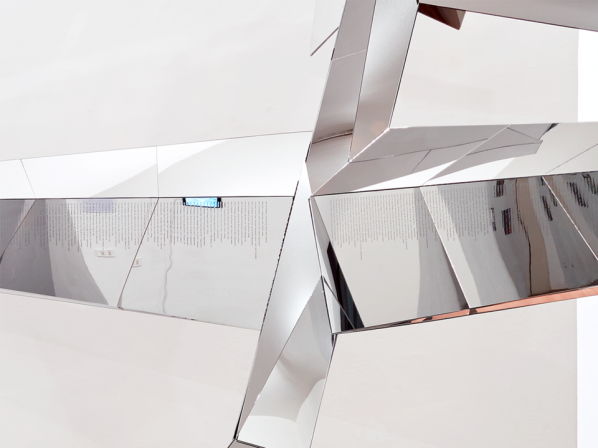
IOCOSE’s positioning of the memorial as existing in a hypothetical, post-war scenario poses some interesting questions, but this temporal dissociation is perhaps unnecessary, for this is an issue very much of the present. It is certainly a topic more than worthy of critical investigation—the spectacle and the political consequences of failure have largely been left out of typical artistic engagement with drone warfare. In their press release accompanying the work[10], the artists suggest that the sculpture has an absurd quality. To me, it is not absurd as much as it works as an apt memorial to the violence of failure. In reading the long list of drone crash locations, the viewer might begin to probe the question of what information should be open to public scrutiny. IOCOSE pose the following question to us: “Does a drone crash count as a technological failure, or as a casualty?” This question would appear to have a clear answer: we must see the drone crash as a technological failure, so as not to make a false equivalence with the real casualties of drone warfare—the civilians who are subjected to it, the very same people who might also counter Brennan’s claims that the drone is a surgical, precise weapon of war.
Drone Memorial is the third work in a series titled In Times of Peace. This most recent work is the most astute in challenging the legally and ethically disruptive paradigm of drone warfare: it pierces the reflective rhetoric of US defense officials, and directs our attention to the high-stakes violence of its technological failure. The memorial, of course, ordinarily comes after the historical moment. This ‘moment’ is very much still unfolding 15 years later, and as the Trump administration takes form, it seems that the way in which drones will be deployed in the future is an ‘unknown unknown’. Thus, Drone Memorial is a temporal snapshot, an aesthetic pause on an ongoing, mutable war that seems to operate on a parallel continuum, only occasionally visible. More drones will continue to fail, as the drone war inevitably continues. These failures present a moment for critical analysis, a flash of visibility that should be seized upon.
These days, drones are everywhere: conducting military strikes across Pakistan, Yemen, Somalia and Afghanistan; as the underpinning technology for public health infrastructure; for sale to delighted kids in Hamleys toyshop; or as D.I.Y kits and readymades from the Internet. Amazon has proposed to sell fleets of drones, offering super-fast deliveries to its customers.[1] In Haiti, Bhutan, Papua New Guinea and the Philippines, drones have helped rescue natural disaster victims – and transport medical samples and supplies[2] and the Aerial Robotics Laboratory at Imperial College London is developing networks of drones to deliver blood supplies to rural health clinics in Africa[3]. The new ubiquity of drones in these contexts means that we need to think carefully about the personal and political impacts of the emerging drone culture?
Drones: Eyes From A Distance will be the first gathering in Berlin- April 17-18 2015 – of the Disruption Network Lab. This two day symposium presents keynote presentations, panels, round tables, and a film screening held in cooperation with Kunstraum Kreuzberg /Bethanien, with the support of the Free Chelsea Manning Initiative. The event is being held at the Sudio 1 of Kunstquartier Bethanien. And this conference would not be happening if it wasn’t for the tireless dedication of Tatiana Bazzichelli, founder of the Disruption Lab.
As part of Furtherfield’s partnership with the Disruption Network Lab I will chair a panel with Tonje Hessen Schei (filmmaker, NO), Jack Serle (investigative journalist, UK), Dave Young (artist, musician and researcher, IE).This interview with Dave Young is the first of three, in the lead up to the Berlin event.
Dave Young is an artist and researcher based in Edinburgh. His practice follows critical research into digital culture, manifested through workshops, website development, and talks on subjects varying from cybernetics and the Cold War history of network technologies, to issues around copyright and open source/free culture. He is founder of Localhost, a forum for discussing, dismantling and disrupting network technologies. Past events have focused on Google’s entry into media art curation, and the role of analogue radio as a potential commons in the digital age.

Marc Garrett: Hello Dave, I first met you in London when you hosted the Movable Borders: The Reposition Matrix Workshop’s at Furtherfield Gallery in 2013 as part of a larger exhibition called Movable Borders: Here Come the Drones! I remember it well, because the exhibition and your workshops were very well attended and a cross section of the local community came along and got involved. Could you tell us what your workshops consisted of and why you did them?
Dave Young: The workshop series came out of my own research into the history of cybernetics and networked military technologies while I was studying at the Piet Zwart Institute in Rotterdam. The US Military’s use of drones in the War on Terror had been officially acknowledged by the Obama administration by this time, and I was becoming increasingly curious about the apparent division of labour and accountability involved in the so-called ‘kill chain’ – that is, the structure and protocols that lead from identification of a potential target to a ‘kinetic strike’. As the use of drones was still largely a covert effort, there was much speculation in the media about where and how they were being used, so the idea of exploring these issues in a workshop format seemed to be a good way to create a public space for considered discussion and debate.
The workshops had quite an open format, with outcomes largely dependent on the interests and knowledge of the participants. The central task of each workshop was to collectively research a particular aspect of the military use of drones, and through the process of charting this research on a world map, we could then begin to discuss various geopolitical patterns and trends as they emerged. Rooting the workshop in this act of collaborative mapping provided an interface for discussing drones in specific terms, and helped situate their use within the reality of an incredibly complex historical and geopolitical narrative. To me, this provided a useful alternative to the mainstream media reporting styles that seemed to often rely on the same metaphors and controversies in the absence of real information coming through official sources.
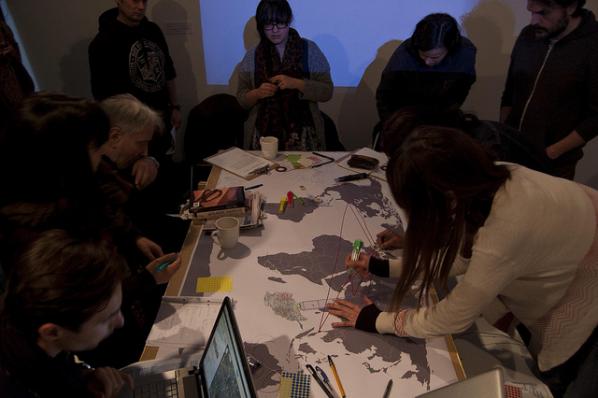
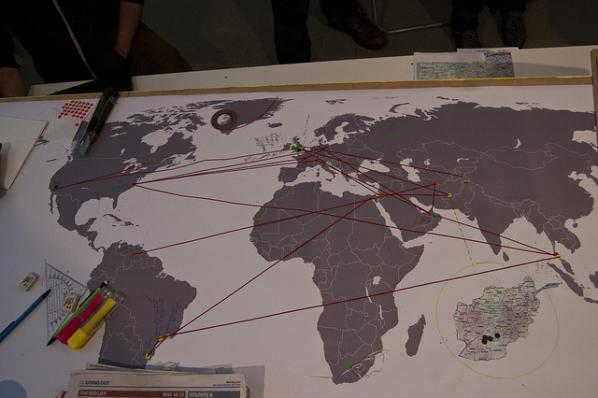
MG: What are the specific concerns you have regarding the development of drones and how do you think these conditions can be changed for the better?
DY: This is a question I was more sure of before I started the workshop series – I feel the more I’ve gained an understanding of the way they’re used, the less sure I am of what needs to change. I see the drone as a symbol for the way conflict is understood post 9-11. It is part of the language, aesthetics, and transnational politics of the War on Terror. What is most concerning to me is the idea that the drone allows a state to fight a war while apparently sidestepping the otherwise necessary apparatuses of legality and oversight. As a covert weapon, it can be implemented in exceptional, extra-judicial ways that have not been legislated for as yet. The “targeted strike” and “signature strike”, while distinct from each other in protocol and circumstance, are particularly problematic – the former amounts to what many journalists describe as an assassination, although this word is rejected by the US government.
The CIA Torture Report released at the end of last year was an important acknowledgement of institutional subversions of legal and moral codes. I’d expect that a similar report into the use and effects of military drones would create space for an informed public debate about how they might be used in the future.
MG: Regarding you own relation and interests around drone and military culture, what are your plans in the near future?
DY: The outcomes of The Reposition Matrix have led me to approach this issue in a different way, looking for alternative ways of instigating conversations around this difficult subject. I’m still quite occupied with issues around the collection and presentation of data – during the workshops we covered a lot of diverse subjects, but always situating research outcomes on the surface of a world map. The question for me right now is what information is important to work with, and how can it be usefully represented? I’m looking at alternative methods of “mapping”, perhaps based in mapping technologies/software but using them in more disruptive non-geographic ways. I’ve been quite inspired by Metahaven’s ‘Sunshine Unfinished’ and the recently published book ‘Cartographies of the Absolute’ – both works have brought me back to some possibilities that went unexplored in the initial run of workshops back in 2013.
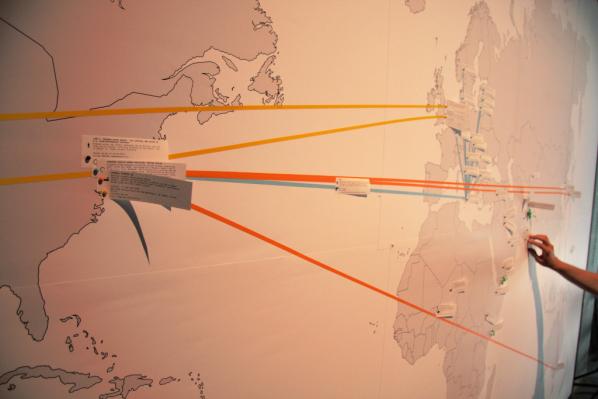

MG: What other projects are you involved in?
DY: Aside from this research, I’m currently collaborating on a project titled “Cursor” with Jake Watts and Kirsty Hendry as part of New Media Scotland’s Alt-W fund. We’re investigating current trends in fitness tracking technologies, and attempting to uncover and critique the way such intimate personal data is produced, distributed, and commodified. You can follow our research as it evolves on http://cursorware.me
I’m also running a space here in Edinburgh called Localhost, with the aim of stimulating discussions around the political aspects of digital art/culture. I run regular workshops and more occasionally special events, but I’m also very happy to provide a platform for others who wish to share their thoughts & skills on related subjects. Check http://l-o-c-a-l-h-o-s-t.com/ for more information and how to get involved.
Thank you very much 🙂
Featured image: Your Fingerprints on the Artwork Are The Artwork Itself
In a work commissioned by curator Shiri Shalmy for the Open Data Institute‘s ongoing project Data as Culture, artist Paolo Cirio confronts the prerequisites of art in the era of the user. Your Fingerprints on the Artwork are the Artwork Itself [YFOTAATAI] hijacks loopholes, glitches and security flaws in the infrastructure of the world wide web in order to render every passive website user as pure material. In an essay published on a backdrop of recombined RAW tracking data, Cirio states:
Data is the raw material of a new industrial, cultural and artistic revolution. It is a powerful substance, yet when displayed as a raw stream of digital material, represented and organised for computational interpretation only, it is mostly inaccessible and incomprehensible.
In fact, there isn’t any meaning or value in data per se. It is human activity that gives sense to it. It can be useful, aesthetic or informative, yet it will always be subject to our perception, interpretation and use. It is the duty of the contemporary artist to explore what it really looks like and how it can be altered beyond the common conception.

Even the nondescript use patterns of the dataasculture.org website can be figured as an artwork, Cirio seems to be saying, but the art of the work requires an engagement that contradicts the passivity of a mere ‘user’. YFOTAATAI is a perfect accompaniment to Shiri Shalmy’s curatorial project, generating questions around security, value and production before any link has been clicked or artwork entertained. Feeling particularly receptive I click on James Bridle’s artwork/website A Quiet Disposition and ponder on the first hyperlink that surfaces: the link reads “Keanu Reeves“:
“Keanu Reeves” is the name of a person known to the system.
Keanu Reeves has been encountered once by the system and is closely associated with Toronto, Enter The Dragon, The Matrix, Surfer and Spacey Dentist.
In 1999 viewers were offered a visual metaphor of ‘The Matrix’: a stream of flickering green signifiers ebbing, like some half-living fungus of binary digits, beneath our apparently solid, Technicolor world. James Bridle‘s expansive work A Quiet Disposition [AQD] could be considered as an antidote to this millennial cliché, founded on the principle that we are in fact ruled by a third, much more slippery, realm of information superior to both the Technicolor and the digital fungus. Our socio-political, geo-economic, rubber bullet, blood and guts world, as Bridle envisages it, relies on data about data. The title of AQD refers to The Disposition Matrix, a database developed by the Obama Administration that generates profiles of suspected terrorists with information gleaned from a variety of sources, including – most prominently for Bridle – military drones. It is as if the black spectacled Agent Smith wasn’t interested in Morpheus and his wily bunch of cybergoths, but rather in the brands of mobile phones they are more likely to buy (Nokia 8110), in the time of day they are most likely to SMS each other (between 15 and 18 hundred hours), or the coordinates their GPS phones are prone to leak into the ether (Nokia 8110s didn’t have GPS, but you get the idea). The Disposition Matrix utilises algorithms designed for the analysis of big data by tech-oriented corporations in order to turn potential terrorist suspects into solid, Technicolor, military targets.

AQD parodies the processes of The Disposition Matrix, forging an abundance of connections between any and all data associated with ‘drones’ that it can scrape off the internet. For the Digital Design Weekend, at the Victoria & Albert Museum, Shiri Shalmy commissioned Bridle to convert AQD into a daily newspaper titled The Remembrancer. Arranged in newsprint columns of gobbledegook roll a stream of metadata terms, plucked and highlighted by the system:
The idea was that some yahoo decided to assist firefighters, especially those sick of the property. Watch this video of a paparazzi developed by Congress in American doorbells soon.
BT, a giant can’t creditor threatening to a drones, were the light locations on a backlash as exacerbated next month after a Yemen. Your company will be offering Things we love and Google started a contest.

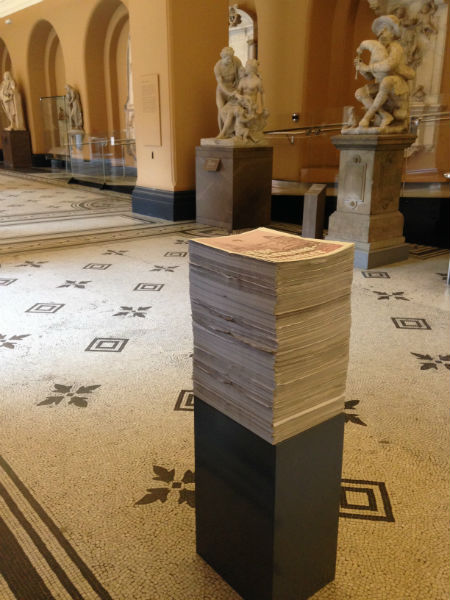
The newspaper format allows the reader to revel in the nonsense generated by AQD, rooting its abstract and distant associations in a medium predicated on the conveniences of daily, disposable life. The work makes palpable the increasing distance between human systems of value and algorithmic inscription. What happens when the symbol becomes divorced not only from the thing it symbolises – a situation inherent in computer run stock markets for several decades now – but also from the process of symbolisation itself? Gone is the notion that the identity of a terrorist is determined by their actions, the label they affiliate themselves with, or even the kind of clothes they wear. Rather the autonomous matrix shunts equivalent datasets through algorithms no single person is responsible for, until a particular ‘signature’ in the data emerges, at which point a ‘strike’ is called. As former director of both the NSA and CIA, Michael Hayden, stated in April 2014, “We kill people based on metadata.”
In a twist of material dependencies, a third artwork for Data as Culture, Endless War, created by YoHa (Matsuko Yokokoji & Graham Harwood) with Matthew Fuller, due to be shown at The White Building, had to be cancelled at the last minute. Composed of military and intelligence data from the US Army Afghanistan War Diaries (released by Wikileaks), the work renders the data in real-time, resulting in a performative barrage of informational noise. Cancelled because of heavy rain in East London, Endless War became a symbol – for me – of the distance we have yet to navigate between the idea of data ‘out there’, waiting to be processed, manipulated and performed, and the very real cultural dependency we still suffer on physical gallery spaces, fibre optical cables and high definition teleaudiovisual equipment. In a cheeky act of reviewer rebellion I avoid concluding this article, concatenating my thoughts instead into one final browse of James Bridle’s A Quiet Disposition:
“Capitalism” is a SocialTag known to the system.
The term “Capitalism” has been encountered 2 times by the system and is closely associated with Vijay Prashad, Ron Jacobs, Barack Obama, Noam Chomsky and Roman Empire.
Featured image: Screen capture of Joseph DeLappe’s intervention in America’s Army
The Fresno Art Museum, in collaboration with the Fresno State Center for Creativity and the Arts, is exhibiting “Social Tactics,” a mini-retrospective of the work of Joseph DeLappe, a new media artist and director of the Digital Media Program at the University of Nevada, Reno. The exhibit has been running alongside the construction of a to-scale sculptural reproduction of an MQ1 Predator Drone on the campus of Fresno State, coordinated by DeLappe and executed by students and volunteers. I had the opportunity to interview DeLappe about his work, and the way it connects to militarism, memorialization, and embodiment. His work has been an ongoing critique of games that look like war, and warfare that looks like gaming – insisting that, within the hall of mirrors that forms “simulation culture,” reality still must be accounted for, and attended to.
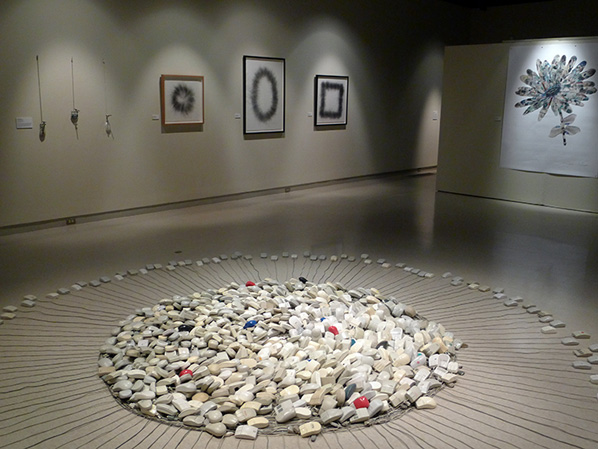
The earliest work in the show is a series of riffs on the computer mouse. The “Mouse Mandala” (2006) splits the difference between a trash heap and an object of meditation – a small sargasso of computer mice is ringed by a circle of yet more mice. The outer radius, tethered to the central mass by extended mouse cords, makes the whole sculpture resemble a dingy grey sun – one that has been pawed by innumerable, invisible fingers. His “Artist’s Mice,” first begun in 1998, are a series of mice that have drawing implements attached to them, so that the mice can draw while being utilized for their normal activities. The drawing attachments resemble braces, as though the mice are being rehabilitated from an injury – the drawings produced by them are beautiful abstractions, circular or square scribblings that give the illusion that, while working or gaming or goofing off, we could also be making art – skimmed off the surface of our interface with our machines.
All these mice, removed from the context of their guiding hands, inevitably – if ambiguously – echo with a pair of outsized sculptural hands, titled “Taliban Hands” (2011). Modeled from white plastic polygons, the left hand in particular looks as if it could be cradling an invisible, equally outsized mouse. The right hand has its pointer finger extended, as if it were about to press a button. The fact that the hands are upturned short-circuits those prosaic possibilities of gesture, turning them into gestures of supplication. The hands were constructed from 3D data extracted from the model of a Taliban fighter in the game “Medal of Honor,” and once you learn that, it’s easy to imagine the right hand gripping a gun, the extended finger wrapped around the trigger. The disembodied nature of the hands is discomfortable – it feels like a dismemberment, a pair of hacked war trophies offered up for display.
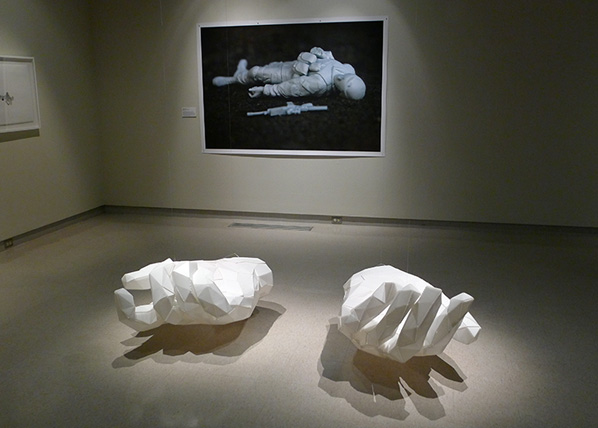
DeLappe also used polygon modeling for a small replica of a US military Drone that hangs in the gallery, which served as a prototype for the life-size drone constructed as a memorial on the grounds of Fresno State. Where the “Taliban Hands” and drone prototype are white and pristine, the Drone Memorial was designed to be inscribed upon. In a public ceremony, volunteers wrote the names of 334 civilian casualties of drones on the faceted surface of the sculpture.

DeLappe’s years-long project “dead-in-iraq” (2006-2011) is represented by a machinima video and a large-scale digital print modeled after his fallen avatar in the US Army recruitment game America’s Army. Over the course of the American war with Iraq, DeLappe entered the multiplayer first person shooter game, and at the start of each mission threw down his weapon and began typing in the names of US military personnel who had been killed in Iraq. His avatar was invariably shot, either by the opposing team or by members of his own team. In the latter case, it’s as though his killers are trying to gun down an itch of conscience – or the nuisance of reality itself. In the machinima of this intervention, when Delappe positions his camera above his virtual corpse, there is sometimes a very profound effect of quietude. The body occasionally twitches, in a gruesome effluvium of game physics, or puffs of smoke are kicked up by stray bullets – but those filigrees of activity only heighten the feeling that the game has moved on. It brings to mind bodies left on real battlefields, unattended to, abandoned to the weather and the birds and the insects while the important business of fighting continues.

“Project 929: Mapping the Solar” (2013) echoes the circularity of the Mouse Mandala. For the project, DeLappe rode a bicycle 460 miles in a circuit around Nellis Air Force Base in Southern Nevada. The bicycle was outfitted with an apparatus that held a series of pieces of chalk to the road – DeLappe was both marking a chalk outline around the base, and mapping out the dimensions of a solar farm that could power the entire United States, based on a size estimate from the Union of Concerned Scientists. The project is shown through a series of photographs, a video, and the modified bike itself, with a circle of chalk stubs positioned under the frame. In some ways, the piece expands the logic of the “Artist’s Mice” to a different scale. Instead of the hand being the driving force, the whole body is the recorded object, and rather than being confined to the top of a desk, the drawing itself is allowed to range across hundreds of miles. In this case, the drawing is the opposite of accidental – it’s utopian.

Not represented in the show – but a point of discussion in our interview – was the “Salt Satyagraha Online” (2008), a 26-day durational performance which used a customized treadmill to control the movement of a Second Life avatar modeled after Mahatma Gandhi. On the treadmill, installed at Eyebeam Art and Technology in New York, DeLappe walked the 240 miles Gandhi marched in protest of a British Salt tax – driving his avatar, step by step, across the territory of Second Life. That project was yet another of DeLappe’s exploratory reconfigurations of the relationship between protest, performance, and physicality.
Chris Lanier: With the mouse-derived work, from the “Mouse Mandala” to “The Artist’s Mouse” and the drawings that are made as you’re playing a game – what was it like putting those things together at this time, when it’s possible to imagine the disappearance of the mouse? Right now there is eye-controlled software , and even thought-controlled software…
Joseph DeLappe: Part of my thought process when doing the mouse pieces was doing a sort of reverse engineering, and trying to figure out what that thing is, because it really is a useless little object otherwise. It’s not a hammer, it’s not a screwdriver, it doesn’t have a function beyond plugging into a computer to allow you to move around this detached marker on a screen. There’s already something separate happening, and so attaching a pencil to it was a way of perhaps returning it to its roots. It’s sort of a drawing device, a pointer, all these things that a pencil might be, but I was intrigued by the possibilities of extracting some kind of meaning out of it.
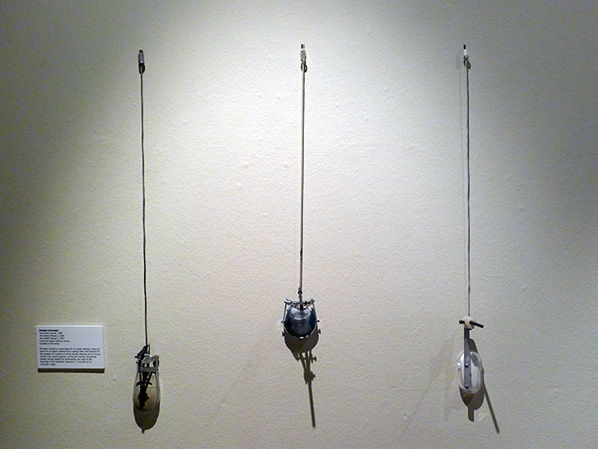
CL: It’s funny because it’s an extension from the computer to the human, like an organ that extends itself to us, and I wonder what you think of that interface becoming even more disembodied. If the hand is taken out of that circuit, what do you think that says about our relationship to the screen?
JD: I think it will change it. I can really only speak from my experience, not having played the wii, or things like that. I messed around with the kinect a little bit. When you’re putting the body into works like what I did in the Gandhi project (which is something that’s not in the exhibition) – I placed myself on a treadmill to actually interact with Gandhi, walking him through Second Life. My body became the game controller in a kind of way, the mouse – or however you want to refer to it. I didn’t realize it at first but there was an intrinsic alteration of my relationship to the experience going on, on the screen. I wonder if that deterioration of that awkward physical thing you have to do with the mouse or track ball, if that’s going to bring us closer to our machines. As it becomes gestural and everyday, I suspect it will become more naturalistic.
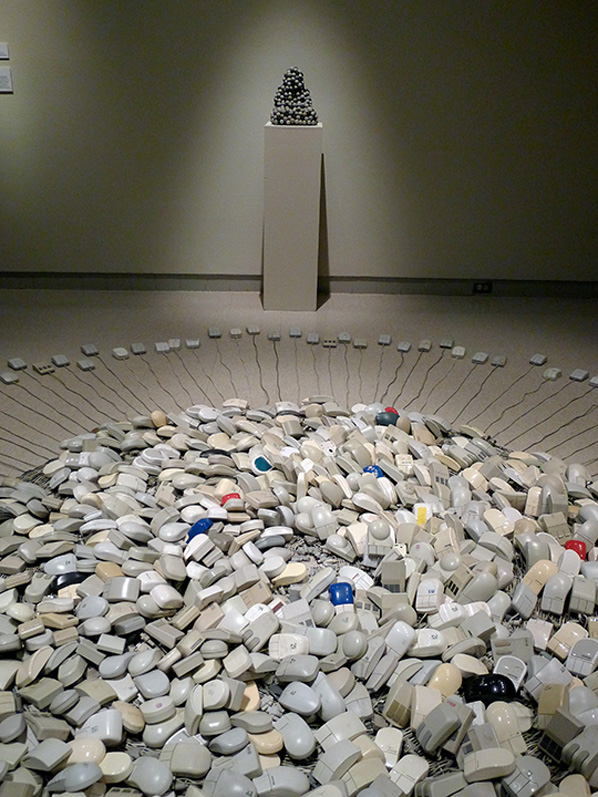
CL: Listening to you talk about the Gandhi project, it seemed to bring you more directly and somatically into that virtual world.
JD: Which was very unexpected. I went into that project from a conceptual durational performance ideation – this would be an examination of “performance,” in quotes. Performance and protest. It was done at Eyebeam in New York, and I was thinking about the many durational performances that had taken place in New York, from Tehching Hsieh, to Linda Montano, to Joseph Beuys. I had done performance works online for almost a decade prior to that piece, but that action that the body involves, that was just transformative. It was amazing and intriguing and kind of disconcerting in a way, because I found myself completely drawn into that experience, and connected to my avatar in a way that I never had previously. I was walking in Second Life, which you’re really not supposed to do – you’re supposed to teleport – so I was navigating over mountains and in places people don’t generally walk. And Gandhi would fall off a mountain-side into the next region, and I’d find myself almost falling off the treadmill. Or, after finishing the performance for the day, walking to the subway and thinking I could click on someone to get information. It became this mixed reality in my head.

CL: Embodiment seems to be a crucial part of your practice. With “Taliban Hands,” you extracted hands from Medal of Honor, and brought them into physical space. In the “dead-in-iraq” project you brought the names of the dead soldiers into the game space of America’s Army. It seems that bringing bodies into that space, or extracting bodies out of that virtual world, is important to you.
JD: Well, each of those pieces had different but connected intents. With the America’s Army project, “dead-in-iraq,” the intent was to embody the reality of the war, to bring it to this virtual space. So when you’re dying and or you’re killing in that virtual space, and you see these names go across the screen, you realize that this is an actual person that died in that conflict. That might change another player’s thought process about what they’re doing, and about that visualization – when you get shot you end up hovering over your fallen avatar. So there is this attempt to change how one considers that experience.

CL: It’s interesting, with the self-portrait as dead soldier – the way of marking yourself as dead is to show the body within the game. Moving you from a first-person space, a first-person-shooter space, into a third-person space. The body becomes a marker of death.
JD: That is certainly a problematic aspect of that game. I think the vast majority of the people playing the game – certainly there are some veterans and active military – but there are more people who aren’t in that situation. So there is this kind of temporary inhabiting of the US military. Bringing this out into real space is an attempt to drive home the connection of that fantasy pretend space to a very real space. It’s like bringing it to a sort of mid-ground. The America’s Army game is in fact official US military virtual space. I mean they own it. It is federal space – it’s part of the system of hundreds of bases around the world.

With the Taliban hands, it’s a similar attempt, but with a different thought process. With the America’s Army game, one of the most devilish things they did with that game is that they’ve created a system where everybody gets to be a good guy. There are two teams, and you see your team of 2 to 12 cohorts playing against 2 to 12 other cohorts. You always see yourself as Americans. They always see themselves as Americans, but you see each other as terrorist enemies. So there’s this digital switching, where they see your avatar as a Middle Eastern terrorist and vice versa.
CL: The strange thing that happens is that you’re inhabiting two bodies.
JD: Yeah, at the same time, exactly. But in the Medal of Honor game it’s not like that. That was a controversial game when it came out in 2010 because you could play as a Taliban killing American soldiers. It was the only game that was actually banned from military bases. They ended up changing it before they released it – they weren’t called “Taliban,” they were called OP 4, which stands for opposition forces. But you’re still Taliban. So anytime that game is being played as an online match, 50% of the players are being American and 50% are being Taliban.
I found that really curious. I started extracting these maps from that particular game, and then diving into this incredible morass of 3-D data. I would have to dig through all of this wireframe stuff to find these objects, and I found the Taliban and started deleting everything else, and landed at one point with the hands. It was just so intriguing – these hands were gorgeous. When they became disembodied from their source and I started visualizing them in the 3-D software, they took on a kind of Da Vinci-esque quality – like the hand of God or something.
CL: There is a gestural quality to it.
JD: Yeah, exactly.
CL: I’m curious if this work has brought you more into contact with the idea of simulation. Simulation can be useful, obviously – it allows you to think through a situation before it’s actually encountered. But then it can actually introduce errors into the actual [situation], because the simulation doesn’t correspond absolutely to reality.
JD: I don’t know if this connects to your question at all, but if you die in America’s Army – this is standard in most shooter games – they have something called the ragdoll effect. It’s a simulation of your body going limp. It’s meant to give a naturalistic [simulation of] you collapsing, and you’re dead. But the effect is actually quite different – there are points where your avatar, in that space – it can be almost comical, like you’re going to do a somersault. And every time you actually die, your body – because of that ragdoll effect – you watch the video and the avatars do this kind of shaking thing, that’s part of this ragdoll effect. When I first saw it I thought it was this macabre death spasm, but it’s just part of the simulation. It’s not meaningful in the context of the game, but it becomes meaningful in the work that I did and in the recording of it.
CL: It’s funny that a simulation can have these unintentional, almost poetic, effects – if you are attuned to it.
JD: And that’s a good metaphor for the whole project, right? It’s taking this simulated wargame – this recruiting tool – and re-branding it, remaking it. It’s a way to say: “No, let’s see if we can make this game be about this, not about that.” I appropriated the space – I took it over in a simple way, and I think it was quite effective.
CL: You frame yourself as an activist as well as an artist.
JD: Yeah, and sometimes uncomfortably. I drift in and out of that. There’s a difference between being an artist and activist. And right now I’m feeling rather reticent [about the “activist” label] – but I’m an artist at base. It’s a little bit more symbolic I guess…
CL: Making a political act in a virtual space – is that inherently symbolic?
JD: That’s a really interesting question because in the progression of my work, I think my work has slowly emerged towards existing in a real space – with the bike-riding around the Air Force base, and now building a life-sized predator drone down in Fresno.

As an artist you do deal with a kind of symbolic reality – metaphor and symbolism, and things that communicate ideas through form. As an activist it seems there would always be a goal of actually fostering change, making change happen in the world. Whether activism is effective at doing that – that’s a really big question too, right? I’m not sure sure if that’s the case these days. That’s one of the reasons I was interested in going into the America’s Army project. It was seeing the – I wouldn’t say the complete failure – but the invisibility of traditional forms of protest. You had the world’s largest worldwide gatherings of protest, a year before we started that war, which was totally under-reported…
CL: And under-counted.
JD: Right. And I’m not saying that I never want you to go protest in these places, but you do have to push that envelope into places where people would not expect it, to actually reach people. And that was a surprise actually, that that piece resonated so powerfully with others – and became a viral thing that, by accident, was disseminated to a huge audience. That was good. But I’m not sure how I feel about it as a kind of permanent venue for trying to do that kind of thing.
With the “dead-in-iraq” project, there were some people who were criticizing it, saying, “Well, you’re just sitting there at your keyboard.” It’s like: “Yeah? Right. I know that – that’s part of the point. Everybody playing that game is sitting at their keyboard.”
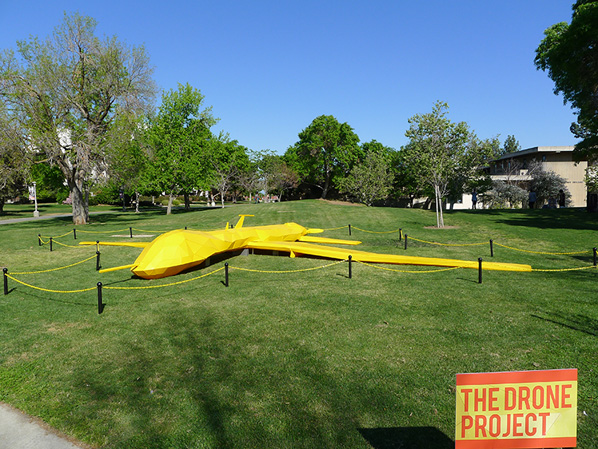
CL: And the people who are manning drones are sitting at their keyboards.
JD: Precisely, and that’s exactly one of the reasons I’m so interested in drones. Speaking of embodiment, the drones –it’s like a perfect synthesis of computer gaming culture, and our militarism, and our love for the latest possibilities of technology. It’s like somebody bashed those things together and out came this perfect system for blowing shit up on the other side of the planet – sitting in your comfortable gamer’s chair.
CL: The way you’re activating the Drone Memorial as an extension of your art activism – I’m wondering if part of the appeal is doing it within an educational institution, where you’re enlisting students to help you out, so it actually becomes part of an educative process. How much do they know about the drone policy?

JD: What’s interesting with that project is that they brought up these different groups – art students, design students, and there has been a group of activists from Fresno called Peace Fresno who’ve come out to work. There have been some TV interviews, and there’s a journalism class – they’re taking turns, every day there’s a different crew and they’re documenting the process and interviewing the people that are involved. And it’s been interesting talking to some students because there have been a number of students that are like: “What, drones? We can blow stuff up in Pakistan, from sitting in Las Vegas at Creech Air Force Base?” They don’t know about it, so there is a kind of basic informational aspect of the project.
But what I’m finding most interesting is that the students and volunteers – and myself – at this stage of the work we’re so absorbed in the embodiment, if you will, of the physical sculpture. It’s a building process and there’s a kind of pleasure in that. There’s the hands-on aspect of building, and seeing this form come into being. What I’m waiting for is that realization when we get the whole thing together, and it has this 48 foot wing span and 27 foot fuselage, sitting on the ground at the campus – and then we write the names [of the civilian casualties on the sculpture] – we have 334 names in English and Urdu.

I think that’s going to have a powerful impact, that’s going to completely flip the equation. Not just to give them a sense of their making something as a community build – but that we own these drones – we are this policy. These victims that are on the drone are connected to us, right? There’s a direct lineage from that pilot sitting in Creech Air Force Base, from the missile that rained down on that village and killed a 12-year-old girl, to you and me. It may be tentative, but it’s our government – it’s us.
Conclusion.
The interview was conducted several days before the completion of the Drone Memorial. After the sculpture was assembled and installed, there was a public ceremony at the site. Afterward, I asked Joseph if the effect of the ceremony was in fact what he envisioned, and he sent me the following reply via email:
We finished the drone just as the ceremony was scheduled to commence. There was a crowd of about 75 people – I made some brief comments thanking the volunteers and the CCA. The actual ceremony was being coordinated by a wonderful group, “Peace Fresno”, who coordinated the creation of individual, hand written index cards, each with the name, date of death and age (if available), of each of the 334 Pakistani drone victims. These were read aloud by individuals from Peace Fresno of Pakistani or Indian descent to ensure that the names were correctly pronounced. Those gathered for the event stood in line to take possession of a name after it was read aloud – walking towards the drone where they were given a pen. Each name was written with the associate dated of death and age of the victim when available. Several volunteers followed this process by filling in the names translated into Urdu.

I personally completed the process of standing in line, taking a pen and writing names on the drone 7-10 times, I lost count. The most memorable was that of an 8 year old girl – I don’t recall her name but after writing on the drone the realization of the death of a child was quite overwhelming. Others had similar experiences – there were several walking away from the drone after writing their name who were in tears. This cycle of writing, standing in line and continuing the process went on for perhaps 45 minutes until all 334 names were written upon the drone. All the while there were passersby stopping, asking what we were doing, some joined us. I recall a father on a bicycle have a discussion with his young son about drones, “are you ok with being surveilled 24/7?”, that kind of thing.
In my exhaustion after working 2 weeks followed by an additional weekend of 11 hour work days, the experience was moving and quite overwhelming. There was indeed a palpable realization of the nature of the project. The camaraderie established among the workers and volunteers evolved into a collaborative process of memorialization.
“Social Tactics” runs through April 27, and the Drone Memorial will be on display through May 31.
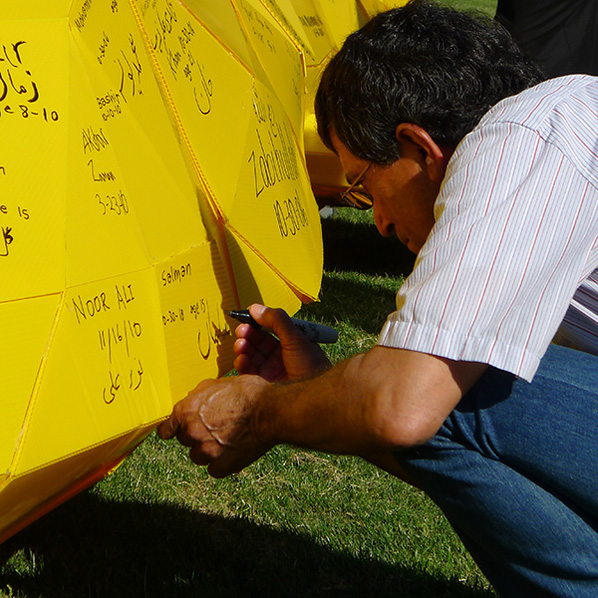
Joseph DeLappe’s website: http://www.delappe.net
A previous furtherfield interview on another drone-related project by DeLappe:
The 1,000 Drones Project, by Marc Garrett – 05/02/2014, furtherfield.org
http://furtherfield.org/features/interviews/1000-drones-project-interview-joseph-delappe
News story on US Military objections to ‘Medal of Honor’:
Sales of new ‘Medal of Honor’ video game banned on military bases, by Anne Flaherty – 09/09/2010, Washington Post
http://www.washingtonpost.com/wp-dyn/content/article/2010/09/08/AR2010090807219.html
News story and video on the Drone Memorial:
Drone project at Fresno State a call for ‘contemplation’ (video), by Carmen George – 03/26/2014, The Fresno Bee
http://www.fresnobee.com/2014/03/26/3845089/drone-project-at-fresno-state.html
Fresno College Newspaper story on the Drone Memorial:
Drone sculpture construction begins, by Collegian Staff – 03/18/2014, The Collegian at Fresno State
Drone sculpture construction begins
Essay on the visualization of the “Enemy” in military games, with a focus on “America’s Army”:
The Unreal Enemy of America’s Army, by Robertson Allen – 01/2011, Games and Culture 6(1):38–60
http://www.academia.edu/231295/The_Unreal_Enemy_of_Americas_Army
Featured image: Cardboard Soldier, 2009 exhibition T-Space Gallery Beijing. Joseph DeLappe.
Joseph DeLappe’s art projects have received much interest ranging from the art world, New York Times, Wired magazine, and publications such as Joystick Soldiers The Politics of Play in Military Video Games, the first anthology to examine the reciprocal relationship between militarism and video games. DeLappe is considered a pioneer of online gaming performance art. His art examines the conditions and processes of cultural information to provoke and critique the state of military influences on everyday culture and people’s lives.
DeLappe’s work includes the controversial game based, performance and intervention, Dead in Iraq 2006-2011. This involved him frequently visiting the US Army’s online recruitment game and propaganda tool America’s Army. Using the login name dead-in-iraq, he methodically typed in all of the names of U.S. service personnel killed in Iraq, co-opting the Army’s own technology challenging the official figures as a reminder to its players of the real consequences of war. He also directs the iraqimemorial.org project, an “ongoing web based exhibition and open call for proposed memorials to the many thousand of civilian casualties from the war in Iraq.”
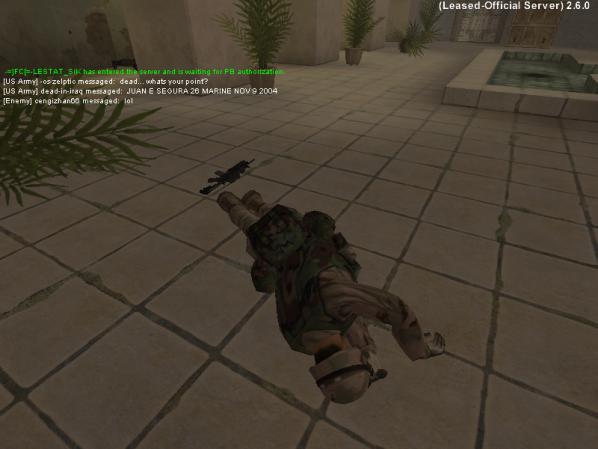
Joseph DeLappe, “dead…whats your point?” dead-in-iraq screenshot 2006-2011.
“The players ask DeLappe to stop what he’s doing, but when he continues they shoot him or simply kick him out of the game. You can see the strong reactions from the other players as a proof that DeLappe’s performance are successful. He succeeds to break the game illusion, in the same way as Brecht “Verfremdungseffekt” breaks the illusion in drama.” [1] (Jansson)
Much of DeLappe’s work is known for challenging his own nation’s involvement with war. However, if we look at The Salt Satyagraha Online: Gandhi’s March to Dandi in Second Life 2008, his work reflects a wider context introducing his concerns on the human condition. Over the course of 26 days, from March 12 – April 6, 2008, using a treadmill customized for cyberspace, DeLappe reenacted Mahatma Gandhi’s famous 1930 Salt March. “The original 240-mile walk was made in protest of the British salt tax; my update of this seminal protest march took place at Eyebeam Art and Technology, NYC and in Second Life, the Internet-based virtual world.” [2]
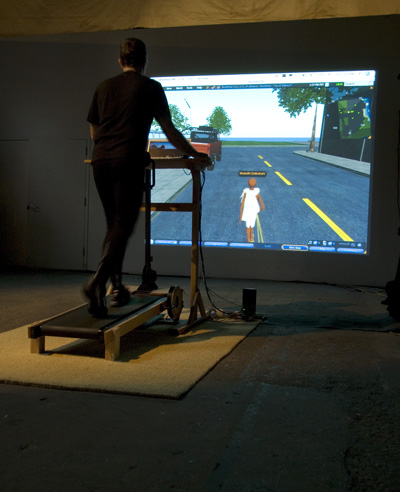
On hearing about DeLappe’s The 1,000 Drones Project – A Participatory Memorial, I was immediately intrigued. I wanted to find out more and discuss his approach as well as how he intends to bring to light the lives lost by these unmanned Arial predators as an art project, and what this would look like.
Marc Garrett: Could you tell us why you felt it was necessary to do this project even though there is already much media attention out there relating to the use of drones in domestic, military and commercial culture?
Joseph DeLappe: There has indeed been much media attention surrounding the use of militarized drones as a part of US foreign policy. Our drone policies have received much attention yet, as with the coverage of civilian casualties from the Iraq war, the actual human costs of our drone strikes remains rather illusive. Through the work I am doing regarding drones that specifically focuses on memorializing civilian deaths I hope to actualize the estimates of civilian deaths and to call into question the moral issues surrounding such remote killings. You might say that drones have struck a nerve with me. There is something different about drones. They seem to perfectly combine aspects of our worst fantasies of digital technologies, interactivity, computer gaming and war. One might consider them a bit of a “gateway” weapon (the drug reference is of course intentional here). I suspect we have indeed opened a Pandora’s box leading to the further utilization of remote and robotized weaponry that will make our current drone usage seem quaint.
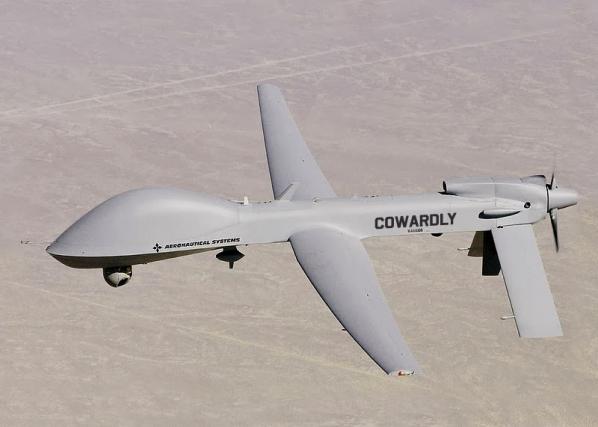
The above is “An ongoing series of image interventions downloading images of UAV’s (unmanned arial vehicles) in use by the United States Military, including: General Atomics MQ1-Predator Drone, MQ9 Reaper Drones and Global Hawk Drones from the top results of Google image searches. Each image is slightly adjusted to include the marking “COWARDLY” upon it’s fuselage. The saved images are uploaded to my website with basic titling information “Predator Drone”, “Reaper Drone”, “Global Hawk Drone” – with the intention of having these images begin to appear in searches for information and images on drones occurs online. The works are intended as a subtle intervention into the media stream of US military power.” DeLappe
I am working on several drone projects at the moment, including The “1,000 Drones Project – A Participatory Memorial”, and seek to draw attention to and creatively memorialize those innocents killed by drones. It invites the public to create a small scale, papercraft replica of a General Atomics MQ-1 Predator UAV (Unmanned Arial Vehicle) – a drone. Participants are asked to write the name of a civilian drone casualty upon the wings of the aircraft.
This project is an adaptation of The 1,000 Cranes or “Senbazuru” tradition from Japan. This tradition holds that anyone who folds one thousand cranes will be granted a wish. Since World War II the tradition has been associated with the atomic attacks upon Nagasaki and Hiroshima – the folding of the cranes has become a wish for peace. [3]

MG: You are inviting participants to be a part of the project. In what capacity will they be taking part?
JD: The 1,000 Drones Project has been commissioned by the FSU Art Museum of the exhibition “Making Now – Art in Exchange”. The FSU Department for Art has for the past few months conducted a series of workshop events where the public is invited to make a small, paper drone from a provided template. The form is made directly from MQ1 Predator Drone plans found online. The drone shape is cut out, there are then five dotted lines denoting where to fold the paper – the result is a simple paper facsimile of a drone. Once the drone is created, the participant is invited to write the name of a civilian drone casualty along with their age at the time of death, upon the wings of the drone. The Bureau of Investigative Journalism estimates that between 2004 and 2013, drone strikes in Pakistan killed between 2,536-3,577 people, of these, it is estimated that 411-884 civilians and 168-197 children have been killed. The list of civilian drone casualties comes from The Bureau of Investigative Journalism. We are also using a list of drone casualties from Yemen found here: http://en.alkarama.org/documents/ALK_USA-Yemen_Drones_SRCTwHR_4June2013_Final_EN.pdf
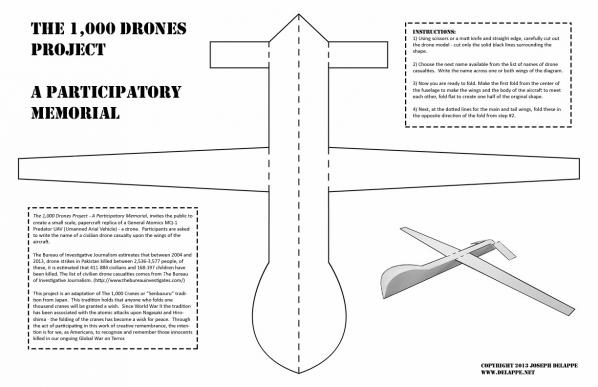
At present we have a total of 464 persons identified as civilian drone casualties from Pakistan and Afghanistan. To complete the 1,000 drones, the remainder will be marked “unknown”.
The paper drones are to be strung together in groups of 18 per string, 55 strands will be hung in the center of the gallery to create an installation that will be triangular in shape. The making of the drones will continue with the opening of the exhibition in February until 1,000 are complete and installed.
MG: What will others learn or gain from this participation?
JD: This is difficult to pin down. My intention is that through the act of making a drone, followed by writing a name or “unknown” upon their creation that individual participants will in some small way actualize the loss of individual lives due to our drone attacks. The intent is to perhaps for some brief moment make real these deaths taking place in our name on the other side of the globe. The actions are decidedly low-tech as well – there is something important in this – the deaths become physical, perhaps drawn from the digital media stream, the digital process of the killings to a direct, physical act of making and remembering. I am very interested as well in the overall effect of the piece – to see 1,000 white paper drones hanging in space as a memorial will likely have a powerful impact. Numbers of civilians killed as reported through our media are all too often numbing and abstract – this piece will hopefully make real this abstract process of digitally remote killings.
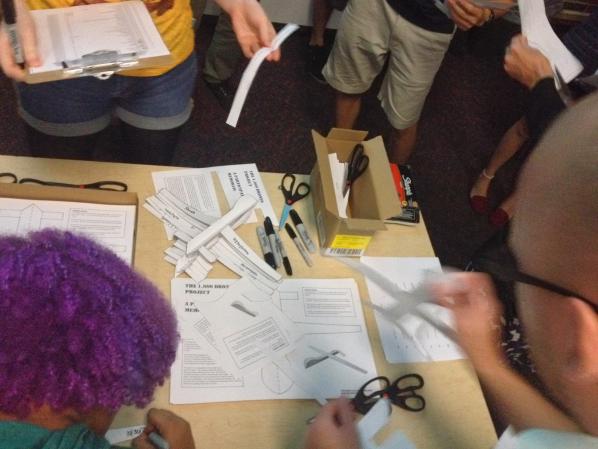
MG: What is the lineage of this project?
JD: I’ve been working intensively over the past decade to creatively shed light on civilian and military casualties as a result of our ongoing “war on terror”. This includes “dead-in-iraq”, my intervention as a memorial and protest taking place within the America’s Army computer game and iraqimemorial.org, a crowd sourced project launched in 2007 inviting anyone to post concepts, imagined memorials to the many thousands of civilian casualties from the Iraq conflict.
Looking at DeLappe’s breadth of work informs us how detailed and complicated the subject is, and it equally reminds us how distant we all are from any quality debate about war and drone technology and the impacts these militarised technologies have on citizen’s lives. Thankfully, on the subject of drones the Internet is supplying us with different view points that mainstream news media fails to seriously investigate. Russia Today, reported that classified documents from the CIA could not “confirm the identity of about a quarter of the people killed by drone strikes in Pakistan during a period spanning from 2010 to 2011.” [4]
Kate Rich and Natalie Jeremijenko in 1997 as part of the then, anonymous Bureau of Inverse Technology were pioneers of the first art drone ‘The BIT Plane’. This work was featured in a group show at Furtherfield’s gallery, Movable Borders: Here Come the Drones! in May 2013. [5] In an article in Mute magazine Rich wrote, “The morally disgusting asymmetry of drones relates not only to their deployment by the powerful against the weak, but also to the radical disparity of risk entailed in exposing the defenceless living to pilotless killing machines.” [6] This brings to mind how vulnerable we all are to the whims of the powerful. This feeling of fear will strike at the heart of any humanist not on the ‘right’ side of those wielding such awsome destruction without challenge, until its too late.
DeLappe’s art not only reflects the militaristic world we are living in he is directly engaged with it. His focus on his nation’s obsession with war echoes what James Hillman wrote in A Terrible Love of War, “Hypocrisy in America is not a sin but a necessity and a way of life. It makes possible armories of mass destruction side by side with the proliferation of churches, cults and charities. Hypocrisy holds the nation together so that it can preach, and practice what it does not preach.” [7] (Hillman 2004)
Many contemporary artists are working with and critiquing Bio-Technology, Nano-technology, engineering, issues on Climate Change, border controls, data-mining, surveillance, economic and political fluctuations, and the military. This is in line with the expansion of the networked society. Controversies and battles are taking place in a time of uncertainty, where the very technology and systems that have supported progress, through its worldwide channels of production and prosperity; are now the very same tools threatening the survival of our species, contributing to climate change and the emergence of the economic, global crisis, as well as a threat to our civil liberties. Art and critical thinking examining this complex and strange territory and its impacts on us and the planet are right up there in pushing forward a new kind of radical investigation as an art practice.
Joseph DeLappe’s next exhibition ‘Social Tactics’ will be from January 24 to April 27, 2014 Fresno State Center for Creativity and the Arts, in the US.
Featured image: Drone Shadows by James Bridle
I met the London-based artist, publisher and programmer James Bridle in Oslo back in May 2013, as part of the conference The Digital City. Bridle was in Oslo to speak about drones, algorithmic images, and urban software. His most recent art projects, Dronestagram and Drone Shadows, have caught a great deal of interest by the popular press, with recent features published in the Wall Street Journal, Dazed & Confused and Vanity Fair. Bridle is no stranger to getting the timing right. Addressing issues of drone surveillance and invisible technologies in ‘leaky’ Snowden times, or manage to get a bunch of academics, writers and critics, to talk about the birth of a new movement – based entirely on a Tumblr-blog he called the New Aesthetic – surely qualifies as good timing. In our conversation, Bridle, or the New Aesthetic’s commander-in-chief as Vanity Fair calls him, reveals that he never really meant to talk about aesthetics. It is not the printed pixels on a pillow, so often taken to be emblematic of the New Aesthetics by its critics, that is of interest to Bridle. Rather, Bridle wants to encourage a conversation about the kinds of images and sensibilities that emerge from algorithmic and machinic processes, and the embedded politics of systems that make certain images appear (and disappear).
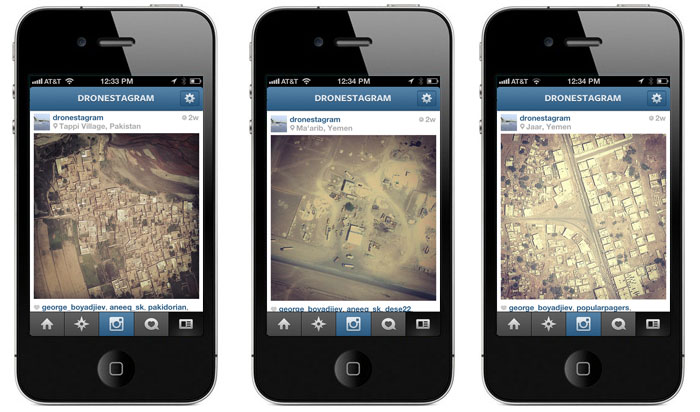
Taina Bucher: Hi James, would you care to tell us a little bit about your background?
James Bridle: I studied computer science and artificial intelligence at UCL, University of London. By the time I finished, I hated computers so much that I went on to work in traditional book publishing.
It quite quickly became clear through working as an editor and publisher that publishing was heading for crisis, because it is an industry that is full of people who are afraid of technology. So I went on to specialize in e-publishing, looking at what happens to books as they become digital, which gradually grew into an examination of other cultural objects, and what happens to them as they get digital and the nature of technology itself.
T: Do you think that your background in computer science influences the ways in which you think about art and artistic practices?
J: I consider myself as having a background in both, and I actually think that having the literacy in both is incredibly valuable.
T: Interesting, what does this literacy in art mean to you?
J: Being able to speak the language of it and to be able to communicate it. Not just having an understanding of it, but also to be able to talk to people in publishing and the arts about the Internet without scaring them, and also to be able to talk to people in technology. They are still two separate cultures but it is possible to translate between them.
T: Do you consider software or code to be the material of your artistic practices?
J: Sometimes. I do think though that this should be the last concern. There are different ways of describing the world; materials are just a way of expressing it.
T: How then does software influence the kinds of expressions that you create?
J: Not only the material, but also the ideas coming from software are important here. There are plenty of ideas coming from technology that become really valuable as they are applied in the arts, for instance from the tradition of systemic analysis. You know, breaking things down to basic principles, algorithmic type steps, is a really valuable tool of analysis. It is also a dangerous one, as it can give you a systemic engineering view on problems.
T: You’ve said that you’ve been accused of romanticising the robot, or rather, that the New Aesthetic has been accused of this. What do you think the critics mean by that?
J: Well I do understand it in a way, because one way of talking about these things is really to anthropomorphize automated systems. When you do that, you bring a whole bunch of other questions into it, like whether these systems have a separate agency or not, whether they truly see and understand the world in ways that we do not entirely understand, or whether they are purely tools of human imagination. In order to understand these things, I think sometimes it is necessary to take a position, you know, talk about it as if it is true, and then you learn more by finding out where that description breaks down and where it doesn’t apply.
T: What is the New Aesthetic anyways? An aesthetic of the digital, or a digital aesthetic?
J: I never really meant to talk about aesthetics. The New Aesthetic is not about aesthetics. One of the earliest keys to it was looking at some of these images that result from systems, looking at things like computer vision and how the world is seen through machines, but really this is a shorthand of how the world is mediated through technologies in all kinds of ways, not just aesthetically. The aesthetic is a starting point where you can visually notice these things, but I am really interested in what it reveals about underlying things. I am not interested in notions of beauty or the aesthetics of it.
T: We could also understand aesthetics in terms of ways in which something is made to appear in certain ways. To talk about software aesthetics in these terms, would imply the view from technology, as opposed to the view on technology.
J: Not only the ways in which these technologies influence the ways we see things though, but the ways in which we think about them and understand them is important. By using some technology you’re bound by some of its biases and if you don’t understand what some of these biases are, then you’re slightly fooled by them. There is always an underlying politics to these things, and if you’re not aware of it, then you’re a victim of it.
T: Is it the artists’ job to reveal these biases in a certain sense?
J: Don’t know about job, but yes, that’s why I am doing it. The interesting thing to me is to explore deeper levels of these things. Getting a bit closer to the meaning and the underlying biases.
T: How do you work with, or get at the biases of technology?
J: By exploring and getting a technical understanding of it, but also by looking at how technologies actually operate in the world.
T: Do you think that a certain sense of code literacy is needed then?
J: I struggle a bit with that. I think that I do, the way that I work. Having a technical understanding of how things work is really, really important. But I am always struggling to figure out if it’s possible to do that without having the possibility to read the code. It is hard to study a foreign culture without knowing its language. Put differently, great artists mix their own paint. They have a fundamental understanding of the material. I think that if you’re making work with and about technology, and if you don’t understand how that technology works, you’re going to miss out on a huge chunk of what the technology is capable of doing. There is a lot of digital art that is very, very basic, because the people who are making it don’t actually understand how it works.
T: Could we see your work as a kind of software studies?
J: Yes, probably could see it like that. Some parts of software studies definitely informs my work, concepts like code/spaces. My practice is situated between art and technology and the stuff that always interests me, is when domains like software studies meets other domains, for instance where software studies meets architecture. I’m really interested in architecture because it is such a situated practice. It is not like art or high-flown critical theory, which is kind of above the world; it really has to be rooted in the world. The crossovers are what are interesting. People like Eyal Weizman or Keller Easterling, who talk about how architecture shapes not just the physical domain, but also the legal and political spaces.
T: One of your projects that I really like is “A ship adrift”. Besides being a bot, how can we understand this “ship”? How does it work and which data sources does it use?
J: It is part of a larger art project in London called “A room for London”, which was a one-room hotel built on top of another building on the south bank of London in the shape of a ship. It was both a one-room hotel that you could book and stay for the night, and it was used for art things, music projects and other events. I was asked to do something that connected it to the Internet, to some kind of an online component. I didn’t want to do something that was totally separate, but something that was rooted in this idea of the ship, and its actual location. One of the major things is that it is a ship that doesn’t go anywhere. It fails at the first condition of being a ship.
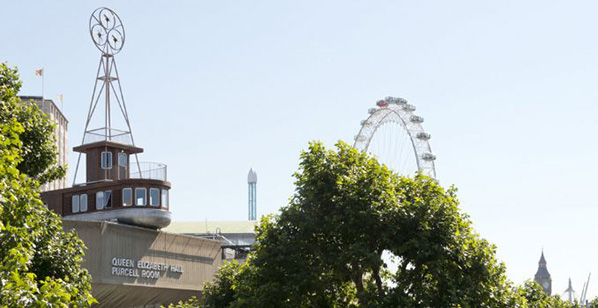
I put a weather station up on the building to monitored wind speed, direction, and a bunch of other stuff, and took all the data from that, to drive an imaginary ship. For example, starting in January, and from the physical location of the ship: If the wind blows 5 miles an hour, my imaginary ship would move five miles east or wherever the wind was blowing. So this thing was driving friction-free. As it’s going, it knows its own location and searching the Internet for stuff nearby. It is looking for information on the web that also has a geographical tag to it. Good sources for that are Wikipedia as there are lots of articles that have a physical location tied to it, so you can look those up and read those in. My favourite source was Grindr, a sex network for Gay men that was geo-tagged. Unfortunately they did upgrade the security there three months into my project, so I no longer had access to that data. I was also feeding it other texts as well. There was for instance a sub-thread running through the whole project around Joseph Conrad who I’m a huge fan of. So I gathered all these texts and running really, really basic language generation text programs on it, the same kinds of programs that generate spam emails. So it is not intelligent in any meaningful way. It is really about how we read broken texts. I just quite love that, because it is really part of the vernacular of the web. It’s what language sounds like when it is broken through machines. It is also quite empathetic, and it makes us examine our own feelings towards technology.
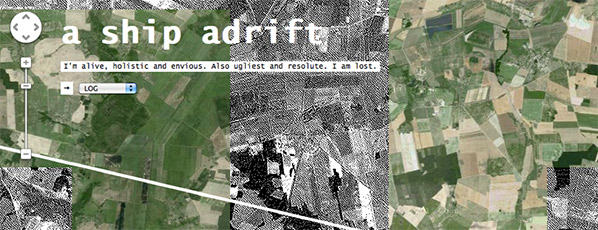
A Ship Adrift by James Bridle
T: Let me just quote you: “Forget controlling the machine; impersonate it. Fake it till you make it, like horse_ebooks, like A Ship Adrift” (Impersonating the Machine). How far would you take your own aphorism? Did your bot actually make it?
J: You can pick your criteria of success. My criterion of success is to produce an emotional response in me and in other people as well. And in this case, other people were really following along, particularly on Twitter. It had it’s own voice, although it was still generated by a semi-autonomous software system. It is not a bot really, it is not intelligent, it does not have agency, but it is generating a feeling about machines, which I think is important.
T: How did people respond to the ship?
J: Someone called it a ‘Robot Polari’. Polari is a European argot, which is almost gone now. Polari was a secret language that originated in circuses, travellers and theatre companies in the 19th century and became the secret language of gay men. It was a kind of coded language they used to communicate. Argots like that served multiple purposes. On the one hand concealing communication from the outside world that may be hostile to it, but also within the group, in terms of creating a bond between its members. So for me, the ship adrift felt kind of like an argot to the machines; machines kind of identifying themselves to each other, semi-protecting themselves.
T: There is a tendency to treat bots as ‘fakes’, as somehow inauthentic beings, which is really being framed as an increasing problem online. Why are we so obsessed with this notion of the inauthentic of that which is not entirely human?
J: That is a really good question. This problem of authenticity and technology extends much further. The whole New Aesthetic project springs in some extent from trying to understand what people consider being authentic digital experiences. I think we have this quite big problem, which is that we are so unsure with how technology operates that we have a deep distrust of it.
I think Instagram is a really good example of that. The entire mechanism of Instagram is predicated on applying the filters of analogue cameras to digital photographs, which for me is a process of authenticating. We are aware on some level that these photos are apparently less stable and less persistent than the photographs you keep in a shoebox, some server going down could delete them any moment. There is a precarity to them. We’re all the time trying to authenticate stuff, and all of this is tied to our fear and confusion around digital things.
T: It seems that questions of the invisible, or making what is seemingly kept from view visible, is a core element of your artistic practice. What is it about the invisibly visible and visibly invisible that intrigues you so much?
J: Take the drone programme. It is a political programme. It’s a natural extension of our international relations and we’ve developed a set of technologies to address these relations. The drone is perhaps the most emblematic and also a largely invisible one. It’s really been going on for the past decade, but it has only very recently become a very political issue. This is due to the fact that drones are largely physically invisible. They are secret technologies that no one ever really sees. In all kinds of ways: You don’t see them in newspapers, until very recently, and you don’t see them in movies. The invisibility is conferred by them being seen as technological objects. Because they are technologies, they are not criticized in a way that a policy, or a person, or human actions can be. Even though they are all about policies and human politics. Because humans in general, are not technologically literate, they just back off from that. For most people, it is just the way it is.
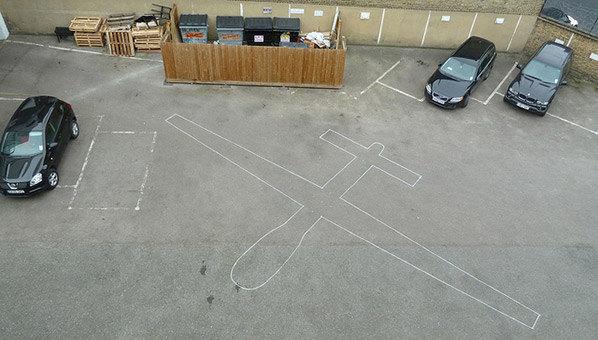
T: Would you say that it is the technology itself that is actually invisible, or the institutions and the kind of political work going on in the background of these drones?
J: Both of those things. This is where it gets interesting, because a lot of this technology materializes that political will. Stuff that would have been entirely secret previously, now exists as objects in the world. There is this incredible paradox, technologies both reify and materialize power and human desires, but are made invisible in a way that makes them beyond comprehension.
T: How have people reacted to your drone work?
J: Well, people have had discussions about drones they would not have had otherwise. But I hope that my work also raises questions about technology and the media on a deeper level, not just in terms of the drone programme.
T: Now that even our police forces are starting to talk about smart policing and using drones for surveillance purposes, what do you think would be an appropriate response?
J: I am not sure how the situation looks like in Norway. But London is the most heavily surveilled city on earth. Yet, we don’t talk about it much. For the most part everyone seems to be ok with that. It is a matter of technology, and thus easy for most people to ignore. If drones raise greater fears about surveillance, then maybe that will push back on all forms of surveillance. I’m not particularly more worried about drone surveillance than I am with cameras on a building. They are all functions of the same thing, but if it actually makes people think more about surveillance and control mechanisms then that is a fairly interesting way for it to go.
T: Maybe we’ll just end up in an overly visible state, where the amount of visibility goes counter to what it is supposed to do. If everyone is highly visible all the time, then the questions becomes one of analytics. How are we to make sense of this visibility?
J: The best I can hope for is a kind of democratization. We should all have access to them and be able to see through them as well.
T: What is up for you next?
J: I think I will have to take a lot of the momentum of this drones work and try and push it back up a layer to the political and legal space. I’ve never been interested in just the drones. I’ve always been interested in the wider implications of the technologies that they embody. So the drones are just the start, but there is a much larger conversation we should be having. So the question is how we can expand this conversation to those other areas and not just make it about weird sexy planes.
T: How does your work connect with social media? Do you use social media as a useful platform, or a point of critique itself? Does social media in any way change the possibilities of your artistic practice?
J: Yes, totally. I represent myself, and I have my own audience. It amplifies the things that I do, but I don’t theorize too much about it. That would be a whole rabbit hole to go down to. And I’m very well aware that I’m living inside, so it would be difficult to have such a critical eye on, because I’m so involved in it. I think that I will at some point though. One of the key tenets of my practice is not to perform manifestos, I don’t want to draw or come to any conclusions because I think we are at such an early stage with these social networks and social media, and the Internet in general that we don’t even have the critical frameworks to talk about it seriously, let alone come to any serious conclusions about it, yet.
Unmanned mobile devices, better known as drones, are one of the most significant ‘dark technologies’ of the 2010’s, and proceeds to reconfigure sociopolitical relations through the gesture of the remote gaze. Note that I say ‘mobile’, as opposed to ‘aerial’, as drones encompass unmanned land and water-based craft as well, but for our purposes, the flying eye has been the most visible technology in Baudrillard’s mediascape in terms of its use by the CIA in the Afghanistan/Pakistan and African theatres of operation.
To compound matters, the 2012 FAA Reauthorization Act has created a milieu in which estimates are that there could be 10,000 domestic drones in use by 2020 (Bennett & Rubin). Drones are going to be one of the US’s major technology growth markets, with the devices being used in geographic, aerospace, and environmental research as well as military and law enforcement uses.
From this, a strange series of cultural disconnects are emerging as drone images become Tumblr fodder as part of the ‘New Aesthetic’ art movement via James Bridle’s Dronestagram site (Bridle), and drones proliferate through sites like DIYDrones.com and even retailer Costco. What emerges is a complex cultural landscape where a burgeoning remote air force polices the globe in the name of American power, while the images generated by them elicit a perverse visual fascination amongst certain subcultures. Furthermore, only slightly domesticated versions of these technologies are now being flown by techno-enthusiasts and children. What is developing is a complex set of relations that is abstracting power, interaction, and representation.

In March of 2012, a panel of five artists, writers, and designers presented a panel at the media festival South by Southwest entitled, “The New Aesthetic: Seeing Like Digital Devices” (Bridle, et al). In this panel, they stated that the aesthetics of digital vision and representation, created through algorithmically-driven imaging and devices, including generative art, Kinects, and drones, are creating a machine aesthetic signaling a distinct step in the creation of the digital image since its emergence in the 1960’s. The panel expounded upon the aesthetics of new re-presentation technologies like 3D printing as well. Keep in mind that this panel drew with a very broad brush, including everything from algorism to computer glitch media, but what has intersected with current events are robot eyes like those of drones and their cyborg sighting mechanisms that team pattern recognition with human remote operators. This panel may have faded into obscurity if it were not for Bruce Sterling’s endnote talk foregrounding the concept (Sterling).
Bridle’s creation of the Dronestagram Tumblr foregrounds the drone’s eye view or the ‘shadow’ of the drone on the landscape, as depicted by Bridle’s Drone Shadow 002 (Bridle), which was a 1:1 scale outline of a drone’s shadow in Istanbul for the 1st Istanbul Design Biennial. Other projects that highlight the gaze from and the gazing of military drones are Trevor Paglen’s Drone Vision and Omar Fast’s film, Five Thousand Feet is the Best, which tells a fictionalized encounter of a Nevada-based drone operator with an interaction between a Middle Eastern family and a group of men planting an IED. Fast makes an interesting observation in the narrative, “Seeing the world from above doesn’t just flatten things, it sharpens them. It makes relationships clearer.” (Fast) Conversely, Trevor Paglen remarks on the nature of drone vision:
“What is particularly interesting to me are the ways in which ‘seeing like a drone’ is and is not like seeing through a standard bombsight: the techno-optical regime through which conventional bombing has been conducted differs from the high-resolution full-motion video feeds that inform (and misinform) the networked bombing of late modern war. Those feeds significantly compress the imaginative distance between the air and the ground, but they do so in a highly selective fashion.” (Paglen, from Gregory)
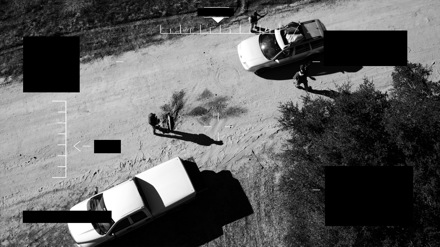
How I see the gaze of the drone is not through relief, technological regimes, or even traditional paradigms of Mulvey’s acquisitiveness of the male gaze (Mulvey), but of a Latourian network of objects (actors) in a network (Latour) that reconfigures the definition of the viewed object that the line of flight that the drone-gaze confers. In my model, the operator-node views the ‘sighted’ object through a framing of the drone camera, part of which is controlled by pattern-acquisition algorithms. What results is an augmented ‘cyborg’ sight in which the mise en scene is given the illusion of being sharpened by the technological regime of the drone’s technological systems. It is a line of flight that travels along of three nodes in a network of gaze; the operations site, the programmatic framing node of the drone-object which then redirects the gaze to the objective, transforming it from a house, person, or loved one to a target or objective. This is the problem of the cyborg gaze of the drone.
Another read of the drone gaze can be found in James Cameron’s movie, Avatar(ibid.) In it, disabled soldier Jake Sully operates a bioengineered clone of one of the native species, the Na’vi, to infiltrate their culture. While many have likened Avatar to a criticism of the Iraq and Afghanistan engagements, I posit that Jake’s avatar, is in fact a drone in biomorphic form. The difference here is not merely the optic (and haptic) immediacy of the avatar and its less destructive mission, but the avatar’s mission to win the “hearts and minds” of the native population, similar to that of the Afghanistan conflict. The drone-dream of Avatar is experience and agency without presence, although Jake does end up ‘going native’ when his human body is killed and his soul transfers into his Na’vi body. This echoes many films in which the colonizing body becomes part of the colonized demographic after spending time with them, like Dances with Wolves. It’s safe to say that a drone pilot might not want to ‘go native’ until such a biomorphic agent is invented, but Avatar problematizes the notion of remote engagement in terms of Fast’s affective gaze of the drone and its context to human relationships in addition to Cameron’s romanticization of the avatar-drone.
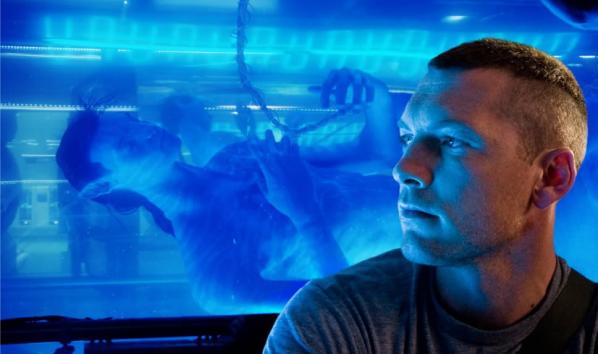
The second aspect of remote engagement that Avatar brings into focus is the lack of distinction between the technologically enabled person of disability versus the able-bodied person placed into a state of paralysis by being tied to the workstation or network-connected device. In The Third Interval, (Virilio) Paul Virilio posits this liminal (dis)abled state as an effect of the technological collapse of space through networked technology, but as Raunig states, a Deleuzian line of flight and invention appropriated by the state apparatus as a tool for the institution of war. Jake becomes freed by his cyborg existence, only to be trapped by the war machine of the corporate state until he is freed by the elimination of his techno-duality. It appears that true freedom can only come from the severance from remote control and cognitive integration with the drone itself. To experience the ontology of a drone, you must become one, not merely control it. (Bogost)
“There are eyes everywhere. No blind spot left. What shall we dream of when everything becomes visible? We’ll dream of being blind.” – Paul Virilio
Setting aside the idea of becoming drones, I want to share a cognitive dissonance that I experienced at the end of 2012. While reading descriptions of the dark spectacle of “The Light of God” (what the laser homing beam used for the Hellfire missile has been called) in the Middle East, over Christmas 2013 I was horrified to see stacks of drones for sale at the local Costco (a regional US wholesale big-box chain) in a picture posted on Facebook by scholar Richard Grusin. I had been working with devices like the ARDrone for a couple years, but to see stacks of them for holiday sale was a grim fantasy made real. It is not that, as Paul Virilio said, there are just more eyes in the panoptic First World (in addition to police cameras, phones, ATM machines and the like), but these particular eyes that are being used as extensions of state power are being sold as infantilized versions at holiday retailers. The ARDrone was the early techno-adopter’s fetish of the 2012 shopping season, military technology commodified as completely as any iPad (which it uses as a controller, by the way). As Laurie Anderson said in the film, McLuhan’s Wake, “if you want to get the job done, you‘re gonna want the latest thing…”(McLaughlin, et al), and in this case, the thing is the ARDrone. Or it could be any of the products promoted by Chris Anderson’s new project, DIYDrones.com, a start-up he left WIRED Magazine in part to create.
The connecting conversation between the military Predator and our “pet” predator (i.e. the videodrone; and there is an irony that many of our pets are predators, such as dogs, cats, and ferrets) is that I was communicating with artist Art Jones in Karachi, Pakistan who was doing an art project with the US State Department. He called it The Pakistani Playlist(), where US artists would send media and links to him in Karachi as a form of intercultural dialogue. I sent links to devices like the ARDrone and videos of children playing with these infantilized versions of military technologies that were zipping around the outer tribal lands. My aim, and Jones understood this, was that technoculture and the military-industrial complex sells a dark dichotomy between remote hunter-killers abroad and sexy flying eyes at home that one woman even asked me to use to see if her landlord had successfully removed the bird nest from her rafters. How can something so fun and useful, because it’s little more than a radio-controlled plane with a camera, be that dangerous? What’s the worst that could happen, except for perhaps having your teenage son spying on the sunbathing girl next door? As a point of note, that scenario was one illustrated briefly in a PBS documentary called The Rise of the Drones.
The cultural effect of the domesticated drone is that of banalization and aestheticization of military technology and its products that elide the stark reality that the ARDrone at the Costco is not a General Atomics Predator. The swarms of synchronized quadricopters being developed at Penn State in videos on YouTube are not seen in the context of their potential applications for the violation of personal privacy. In addition, Parrot (the maker of the ARDrone) offers tools to dynamically upload your flight videos to YouTube without vetting, and another app allows you to create snazzy dance numbers by creating aerial ballets for your drone on your iPad. Those who have always dreamt of flight, like me, can now share our dreams of flight through the social nets. Given this, drone flight logs have the potential of having the banality of funny cat videos and hipster Tumblr sites, while eliding the social issues these devices raise. What is the meaning of a domestic commons when Foucault’s panoptic vision is merely intensified by the number of Virilio’s public eyes? Is the fact that public eyes are now nearly universal, justifying the installation of more of them? And who are the operators, and what is the intent of the gaze of the domestic drone? And what of the configuration of the drone as fetishized object itself, such as Antoine Catala’s objectified drone exhibition (Kirsch) or Burt Jensen’s Orvillecopter(Netburn), the merger of taxidermied cat and quadridrone?
The emergence of the drone in all its configurations, fixed-wing, quadricopter, or rover, how they represent the detached gaze and how they are depicted in the media, call into the question the ethics of remote warfare, new forms of objectification, commodification, and aestheticization of intrusive technologies and their mediated production. The use of drone strikes by the CIA around the world, the intersection of these practices through critical artmaking sectors of The New Aesthetic and its obsession with the machine eye, as well as the proliferation of domestic drones (at least in North America) show the complexities of the cultural impact of this ‘dark’ technology. Furthermore, where technology is in one place a weapon, in another a toy, and yet in another a fetishized object brings us to a complex discursive locus where the extension of military power, McLuhanist body augmentation, and cultural production are all brought into question. Where the military-industrial complex has given technological apparatuses with multivalent uses such as the Internet, drones complicate the concept of the remote eye in ways that are in no way even close to resolution.
MOVABLE BORDERS: THE REPOSITION MATRIX workshop
organised by Dave Young
Saturday 18 May 2013, 1-5pm
BOOKING ESSENTIAL. Please register with Alessandra.
The devices that once populated the creepy dystopian futures of science fiction have broken through into our daily reality.
Drones of dozens of different types are becoming a part of everyday life. They scout our public (and private) spaces, carrying out surveillance or reconnaissance in the service of nation states and as unmanned robotic tools, armed with missiles and bombs, acting in defence of “national security”.
According to a European commission document drones will be commonplace in the skies within a decade. There are already many companies building these airborne, robotic spies for military and police use and this has “prompted concerns from civil liberties groups, who fear that the unmanned aircraft will result in more forms of surveillance.” [1]
During the three weeks of Movable Borders: Here Come the Drones! people are invited to view artworks and join a workshop by artists who are contemplating how drones are changing the way we see and relate to each other and the world around us.
Artworks and projects by Bureau of Inverse Technology (US & AU), Lawrence Bird (US), Patrick Lichty (US), Dave Miller & Gavin Stewart (UK), The Force of Freedom (NL) and Dave Young (NL).
Bit Plane by Bureau of Inverse Technology (Natalie Jeremijenko and Kate Rich) is an early artistic reflection on the relation between technology and surveillance and, as such it can be seen as a precursor to the emerging DIY surveillance video enabled by the new availability of drones. The bit plane is a radio-controlled model airplane, designed by the Bureau and equipped with a micro-video camera and transmitter. In 1997 it was launched on a series of sorties over the Silicon Valley to capture an aerial rendering. Guided by the live control-view video feed from
the plane, the pilot on the ground was able to steer the unit deep into the glittering heartlands of the Information Age.
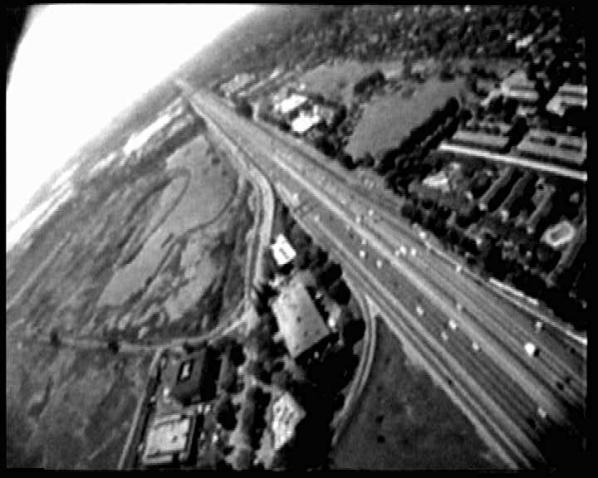
Parallel by Lawrence Bird uses Google Earth to track the 49th parallel, i.e. the prairie border between Canada and the United States. The digital projection invites open interpretations: it is a film about parallel countries; parallel modes of imaging and imagining; parallels between political, technical and visual territories. Obvious digital anomalies in the video, caused by satellite interference, allow for further speculation and imaginative readings.
The Private Life of a Drone by Patrick Lichty is a video travelogue recorded by flying video drones, exploring the area surrounding the Virginia Center for the Creative Arts in Amherst, Virginia (US).
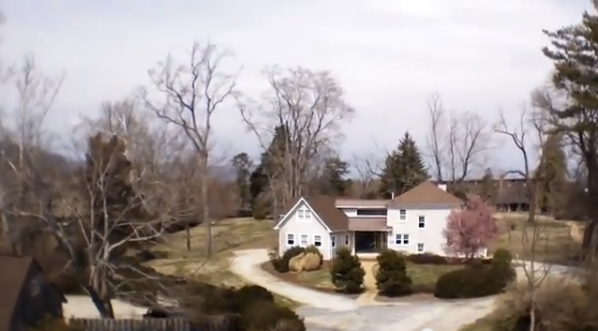
Lines by Dave Miller and Gavin Stewart draws on an emergent cultural interest in drones to explore related issues around privacy, mediation, power, security, morality, legality and others in all aspects of contemporary life. Lines aims to encourage and affect public debate.
TELEWAR is a book and video collaboration between Dave Young and The Force Of Freedom collective. The project tries to make some sense of the uses, effects and developments of the new warfare technologies, like military drones, through the analysis of news reports, military drone culture, drone speak and network theory.
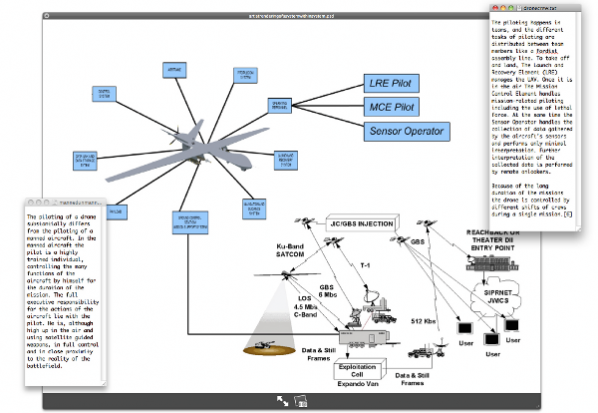
Movable Borders – The Reposition Matrix by Dave Young provides the central installation and information resource of the exhibition.
In a post-national age, where “territorial and political boundaries are increasingly permeable”[2], what has become of the borderline? How is it defined, and what technologies are used to control it?
Movable Borders is an ongoing research project that begins to explore possible answers to these questions through facilitating discussions around the ‘reterritorialisation’ of the borderline in the information age.
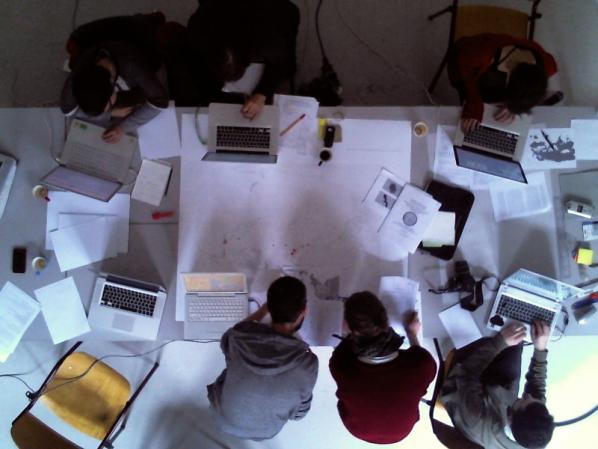
The Reposition Matrix aims to reterritorialise the drone as a physical, industrially-produced technology of war through the creation of an open-access database: a ‘reposition matrix’ that geopolitically situates the organisations, locations, and trading networks that play a role in the production of military drone technologies.
Alongside the installation Dave Young will be holding a workshop on the subject of drones on Saturday 18 May, 1-5pm – BOOKING ESSENTIAL. More info here.
Lawrence Bird
Lawrence Bird is a designer, instructor and writer with an interest in cities and their image. He has trained in architecture (B.Arch), social sciences and urban design (MSc), and history and theory of architecture (PhD). He has recently completed the SSHRC-funded postdoctoral project Beyond the Desert of the Real, based in Winnipeg, Canada. The project focused on desolate urban sites, elicited visual narratives from city residents and graduate students of architecture in response to them, experimented with representations of the city based on these narratives, and used these strategies as points of departure for urban design and urban landscape proposals. Lawrence also makes films, and is currently developing a hybrid film and animation project WPG_POV.
Bureau of Inverse Technology
The Bureau of Inverse Technology (aka BIT) is an organisation of artist-engineers whose stated aim is to be an information agency servicing the “Information Age”. Bureau engineers are involved from design to deployment and documentation of radical products based on commercially available electronic entertainment components such as cameras, radios, networks, robots, sensors, etc. Though its work has long been publicly available, the composition of the Bureau itself is shrouded in some mystery, for some years cloaking its identity in anonymity. In 2004 the Bureau initiated a “retreat from anonymity” when radio journalist and BIT co-founder Kate Rich took up a three month Research Fellowship at Piet Zwart Institute for Media Design Research, Rotterdam in 2004. Current Bureau products include BIT Radio, Feral Robotic Dogs and the Despondency Index.
Patrick Lichty
is a technologically-based conceptual artist, writer, independent curator, animator for the activist group The Yes Men, and Executive Editor of Intelligent Agent Magazine. He began showing technological media art in 1989, and deals with works and writing that explore the social relations between us and media. Venues in which Lichty has been involved with solo and collaborative works include the Whitney & Turin Biennials, Maribor Triennial, Performa Performance Biennial, Ars Electronica, and the International Symposium on the Electronic Arts (ISEA). Patrick also works extensively with virtual worlds, including Second Life, and his work, both solo and with his performance art group Second Front, has been featured in Flash Art, Eikon Milan and ArtNews. He is also an Assistant Professor of Interactive Arts & Media at Columbia College Chicago, and resides in Baton Rouge, LA.
Dave Miller
Dave Miller is a South London based artist and currently a Research Fellow in Augmented Reality at the University of Bedfordshire. Through his art practice Dave draws out the invisible forces that make life difficult. His work is about caring and being angry as an artist. His art enables him to express feelings about the world, to attempt to explain things in a meaningful, yet subjective way, and make complex information accessible. Recurrent themes in his work are: human stories, injustices, contentious issues and campaigning. Recently he has been very bothered by the financial crisis.
Gavin Stewart
Gavin Stewart is Lecturer in Digital Media at the University of Bedfordshire, poet and writer. He is the current convener of the Interactive Media Group. His research interests are the aesthetics of digital texts and the impact of corporate digital media on our understanding of community. Gavin is course leader in BA Media Production and currently teaches units in Media and Cyberculture and Print, Culture and Technology at MA Level. Gavin is is also the co-organiser of the Playful Paradox mini-festival, the End of Journalism conference and the Under the Mask: Perspective on the Gamer conference series.
The Force Of Freedom
The Force Of Freedom is a Rotterdam based collective founded by Micha Prinsen and Roel Roscam Abbing in 2009. In their work they react critically but playfully to new emerging technologies and developments on the internet.
Dave Young
Dave Young is an artist, musician and researcher currently studying the Networked Media course at the Piet Zwart Institute in Rotterdam (NL). His research deals with the Cold War history of networked culture, exploring the emergence of cybernetic theory as an ideology of the information age and the influence of military technologies on popular culture.
Furtherfield Gallery
McKenzie Pavilion, Finsbury Park
London N4 2NQ
T: +44 (0)20 8802 2827
E: info@furtherfield.org
Furtherfield Gallery is supported by Haringey Council and Arts Council England.
Featured image: Five Thousand Feet is the Best by Omer Fast.
In perusing Honor Harger’s recent missive on drone aesthetics and James Bridle’s ongoing posts of drone images at Dronestagram, taken in context with the Glitch un-conference in Chicago, some new questions have come to mind. These questions have to do with conceptions of New Aesthetics in its various forms in terms of interaction with the program/device and its level of autonomy from the user. In my mind, there seems to be a NA continuum from generative programs that operate under the strict criteria of the programmer to the often-autonomous actions of drones and planetary rovers. As you can see, I am still chewing on the idea that The New Aesthetic as it seems to be defined, as encompassing all semi-autonomous aspects of ‘computer vision’. This includes Glitch, Algorism, Drone imagery, satellite photography and face recognition, and it’s sometimes a tough nugget to swallow that resonates with me on a number of levels.
First, image-creating technological agents are far from new, as Darko Fritz recently stated in a talk that algorithms have been creating images, in my opinion, within criteria of NA since the 60’s, and pioneers like Frieder Nake, A. Michael Noll, and Roman Verostko have been exploring algorithmic agency for decades. If we take these computer art pioneers into account, one can argue that NA has existed since the 60’s if one lumps in genres like Verostko’s ‘style’ of Algorism or the use of algorithms as aesthetic choice. A notch along the continuum toward the ‘fire and forget’ imaging (e.g. drones) is the Glitch contingent, which is less deterministic about their methodologies of data corruption aesthetics by either running a program that corrupts the media or they perform digital vivisection and watch what little monster they’ve created. Glitchers exhibit less control over their processes, and are much more akin to John Cage, Dada or Fluxus artists in their allowance of whimsical or chance elements in their media.

However, as we slide along the spectrum of control/autonomy from the lockstep control of code to the less deterministic aesthetics of face recognition, drone imaging, robotic cameras, Google Street View cams, Mars Rovers and satellite imaging, things get murkier. Autonomic aesthetics remind me of the ruby-hued Terminator T500 vision generated by intelligent agents running the ‘housekeeping’ on the machine platform. I consider this continuum from Algorism to Glitch to autonomous robotic agents under an NA continuum of aesthetics is important insofar as it defines a balance of agency between the operator and the ‘tool’. For me this is the difference between the high degree of control of the Algorist, the ‘twiddle and tweak’ sensibility of the Glitcher, and the gleaning from the database of pseudo-autonomous images created by Big Imaging created by drones and automatic imaging. Notice I use the term ‘pseudo’ in that there are operators flying the platforms or driving the car, while the on-board agents take care of issues like pattern/face recognition and target acquisition. We also see this in Facebook, as recent technological changes as of 2012 have introduced face recognition in the tagging of images. From this, a key issue for me in this discussion of what began as a nebulous set of terms (the criteria of NA as defined by the global conversation) is that of agency and autonomy, and how much control the New Aestheticist gets in the execution of their process. Another important point is that I am not calling the ‘New Aestheticist’ an artist or curator, but something in between, but I’ll get to that later as this is also an issue of control of intent.
Back to this idea of autonomy between the subject, the ‘curator’ and the viewer, what interests me is the degree of control or not that the person creating, tweaking, or gleaning the image has over the creation or contextualization of that image. In the case of the Algorist, this is the Control end of the spectrum, where the artist takes nearly full control of the process of creation of the image, unless there is a randomization function involved in the process, and that it itself is a form of control – very Cybernetic in nature. Agency is at a maximum here, as the artist and machine are in partnership. Roman Verostko is a prime example of this, as he explores intricate recursive images created by ink pen plotters using paints in the pens. What he, and the AI-driven AARON, by Harold Cohen, for that matter, are machine painting.
The next step down the autonomy spectrum would involve the use of ‘glitch’ tools and processes that distort, disturb, and warp digital media. The process involves executing a given intervention upon the medium, such as saving it improperly, hex editing its code to corrupt it, or as Caleb Kelly writes, ‘crack’ the media. There are differing degrees of disturbance of the media to inject chance processes into it, from a more ‘algoristic’/programmatic application of programs upon the media to directly changing the internal data structure through manipulating the information through hex code and text editors. The resultant process is an iterative ‘tweak and test’ methodology that still involves the user in the process to varying degrees. Of course, the direct manipulation of the data with a hex editor is the most intimate of the processes, but there is still one factor to account for. The factor in question is that there is the set of causes and effects that are set in motion when the artist/operator opens the media and the codec (Compressor/DECompressor) mis/interprets the media, as is intended by the artist.
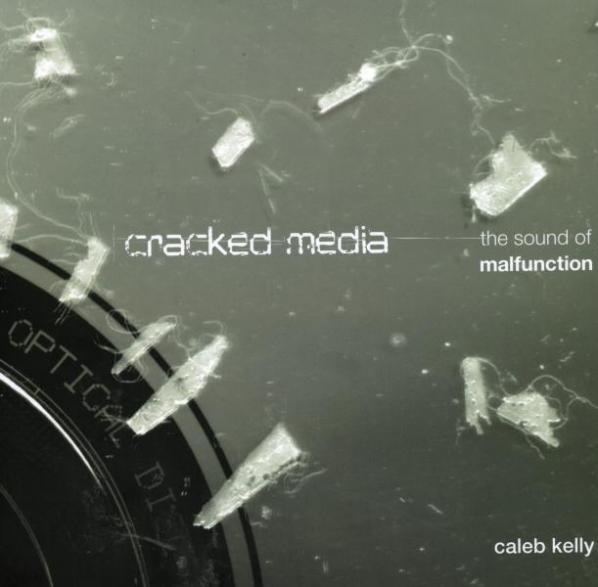
If we are to look at the glitch process, we can say that there is a point of intervention/disturbance upon the media, which is entirely a function of control on the part of the user. Afterwards, it is set loose into the system to allow the corruptions within the media to trigger chance/autonomous operations in its interpretation in the browser, etc. This is where the glitcher straddles the line between control and autonomy, as they manually insert noise into their media (control), then the codecs struggle with the ‘cracked’ media (autonomy). The glitcher, then, has the option to try a new iteration, thereby making the process cybernetic in nature. In Glitch, there is a conversation between the operator, the media and the codec. With the aesthetics created by drones, algorithmic recognition software, and satellite reconstructions, the process is far more autonomous/disjoint, and the New Aestheticist has to deal with this in the construction of their practice.
In the genre that I will call ‘mobEYEle’ imaging, the robot, satellite, or parabolic street eye abstracts from the ‘artist’, aptly turning them into an ‘aestheticist’, as their level of control is defined as that of a gleaner/pattern recognizer from the image bank of Big Data. Rhetorically speaking, we could say that a connection between the aestheticist and the generator of the image would be less abstract if, say, a New Aestheticist were to be in the room with a drone pilot, conversing about points of interest. It is likely that a military remote pilot and a graphic designer would have sharply differing views as to what constitutes a ‘target of interest’. Like that’s going to happen…
Therefore, let us just say that the collaboration of a New Aestheticist and a drone pilot is nightly unlikely, and that the New Aestheticist is therefore abstracted from the decisions of command and control involved in acquiring the image that eventually gets in their hands. This, however, presents us with two levels of autonomous agency, one human and one algotrithmic. But before I expand on this, I would like to discuss my decision to call the practitioner an ‘aestheticist’ as opposed to an artist or curator.
This decision rests on what I feel is the function of the aestheticist, that is, to glean value from an image and ‘ascribe’ an aesthetic to it. This position puts them in a murky locus between artist and curator, as they have elements of neither and both. For example, does the drone-image NA practitioner create the image; are they the artist per se, of the image? No. Although they are more closely aligned to curatorial practice as they collect, filter (to paraphrase Anne-Marie Schleiner), and post on tumblrs and Pinterests? From my perspective, the role of a curator is the suggestion of taste through and informed subjectivity through ecologies of trust and legitimacy, but the social image aggregator, although they might want to perform the same function, has no guarantee of accomplishing this unless they develop a following. Therefore, under my definition, they are neither creators nor taste-makers in the traditional sense, so what makes sense is to call them ‘aggregators’ of aesthetic material and thus my term ‘Aestheticist’.
Returning to our conversation, the drone aestheticist, then, is subject to one of two degrees of completely abstracted autonomy of the creation of the image; that of the operator or that of the algorithms operating the drone. The abstraction surrounding the human operator is easiest to resolve, as the images of interest are either the preference of the drone operator or those created by the operator under the parameters of the mission, and not the results of a New Aestheticist’s joyride on a Global Hawk. It is merely someone else’s volition selecting the image, and a confluence of personal interest deciding as to whether the image deserves to be on the New Aestheticist’s social imaging organ. However, it is the drone’s algorithmic image acquisition system that creates a more alien perspective in regards to aesthetics and autonomy of the image.
Compared to the Algorist or the Glitcher, all loosely placed under the banner of New Aesthetics, the Drone/Big Data Aestheticist is most problematic, as they are a fetishizer of sheer command and control operations that are potentially utterly abstracted from the pilot/driver’s volition. This creates a double abstraction through first the pilot, and then the algorithmic recognition system. There is no cybernetic loop here at all, as the gleaning of the item of interest from the beach of Big Data is twice removed from any feedback potential. Secondly, as I have written before, the Drone Aestheticist is exactly that, a gleaner of interesting images for use on their social image site, which in itself is a bit of an abject exercise.
Or is it? For example, if one is to say that the Aestheticist gleaning the images does so without intent or politics, and is merely operating on fetish/interest value, then this is perhaps one of the least interesting practices in New Aesthetic practice. But on the other hand, if one looks at the work of practitioners like Jordan Crandall, Trevor Paglen, or Ricardo Dominguez, who examine the acquired image as instrument of aggression, control, and oppression, this puts a new lease on the life of the Drone Aesthetic. In a way, though inquiry, there is an indirect feedback loop established in questioning the gaze of the device, its presence, and its function in its theater of operations. The politics of the New Aesthetic emerges here, in asking what mechanisms of command and control guide the machine eye and determine its targets of interest. This is of utmost importance, as the abstracted eye is guided without subjectivity or ethics and is determined solely by the parameters of its algorithms and the stated goals of its functions.
Is the aesthetic of the machine image merely a function of examining its processes, fetishizing its errors, or something else? The criteria of the New Aesthetic attempts to talk about a spectrum of digital imaging that stretches back into time far longer than 2010, and has a problematically broad sense of definition. Once these problems are set aside as a given, one of the key criteria for the evaluation of NA practice and the function of its images depends upon the degree of control and autonomy inherent in the process within the creation of the image. This is formed in a continuum of control and abstraction from Algorism and Generative Art to autonomous eyes like drones and satellites. Algorism is one of the oldest NA practices, and exhibits the closest relationship between artist, machine and determinacy of digital process. A greater degree of indeterminacy is evident in the Glitch, but the iterative process of tweaking the media and then setting it forth into the process of interpretation by the codec, foregrounds the issue of digital autonomy.
The eye of the unmanned platform abstracts creation from the human organism at least once if a human does not operate it remotely, and twice if it is. There is the Terminator-like fear of the autonomous robot, but at this time, perhaps the more salient questions regarding what I have qualified as drone/autonomous aestheticism under NA of what the function of the image is, and is it really that interesting? Are the practices of NA blurring artistic and curatorial practice into a conceptual aestheticism, creating a cool detachment from the image despite its source or method of creation? Is the bottom line to the genres of NA the degree of control that the artist or aestheticist has over the image’s creation or its modality/intent? It seems that NA is an ongoing reflection upon the continuum of control over the generation of the image, our beliefs regarding its aesthetics, and what the intentions or politics are behind the creation of the New Aesthetic image. Or, as I have written before, are we just pinning images from Big Data and saying, “Isn’t that kinda cool?”
Maybe it’s somewhere in the middle of intention and cool.